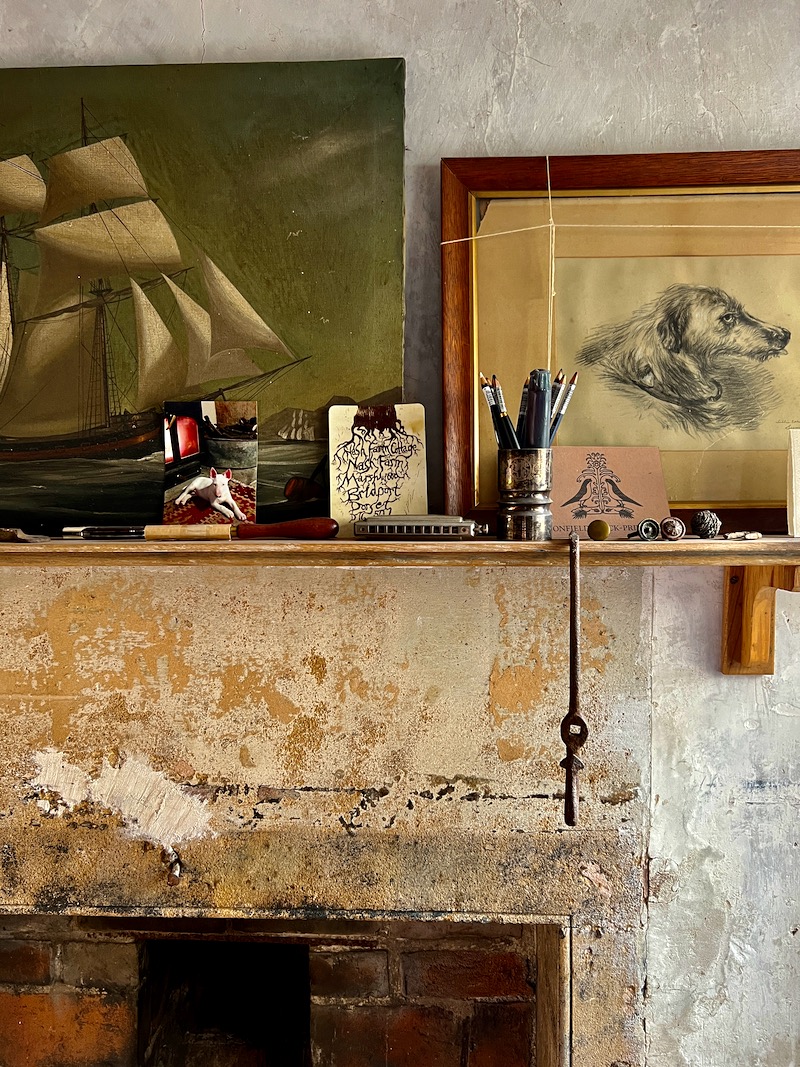
This is Bonfield Block-Printers, the workshop and home of Janet Tristram and Cameron Short and family, in Thorncombe village, Dorset.
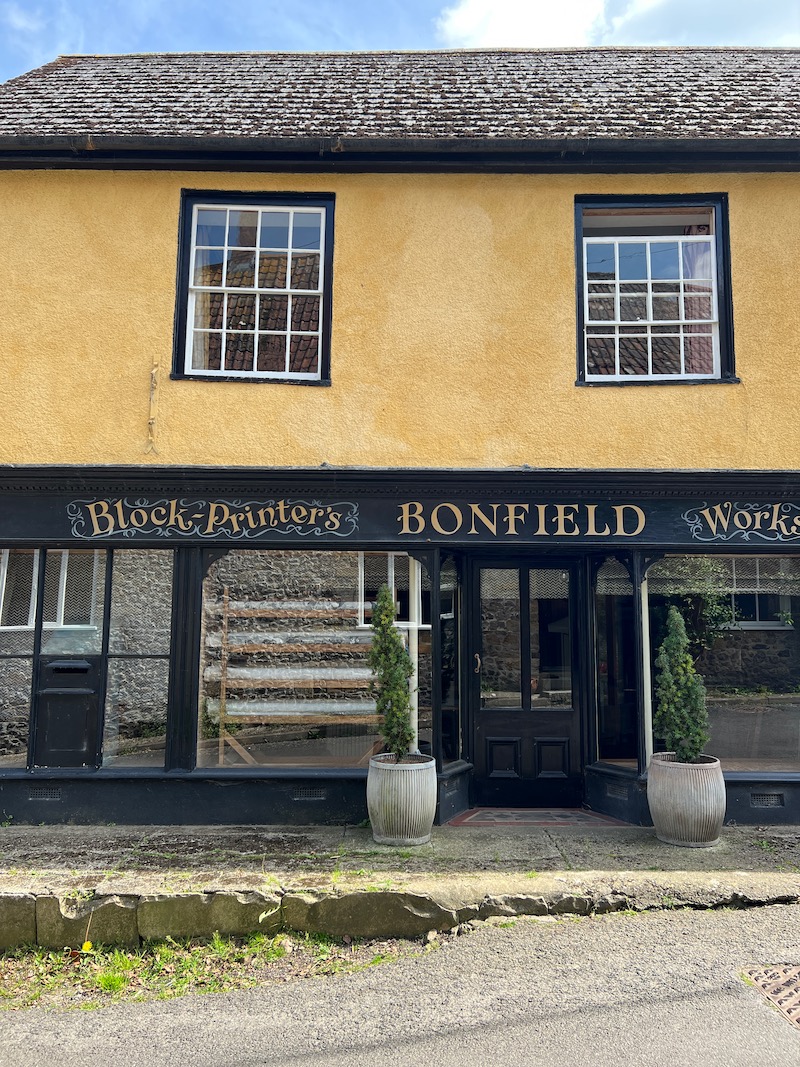
They came here about 9 years ago – This is their story, told by them both. ‘Cameron was hedgelaying. So I used to drop him at the village shop, so we knew Thorncombe – and we used to drive past this place. It came up for auction, it was completely derelict , it was a low guide price, we’d come to view it. There were no walls or floors, there’d been a big fire in here and the owner was ill, he had ended up living in a caravan, there were trees blocking the sky and old cars everywhere, the council had become involved. It was listed Grade II, its core is seventeenth century.’
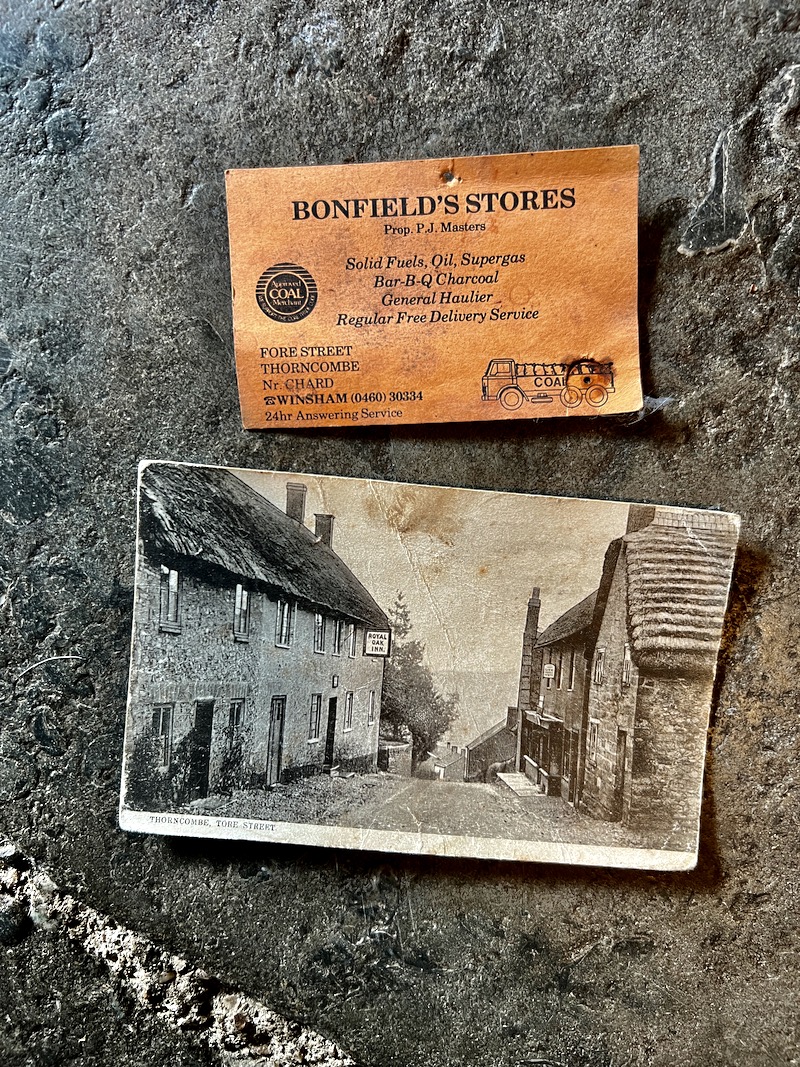
‘We were living on this incredible mother and daughter farm, in a tiny cottage with two children and another on the way. It was frugal, there was black mould and a crappy little oven, it was freezing, no heating but amazing views, the Marshwood Vale, all the high points of Dorset, the Horseshoe. I’d fold the washing and day-dream.’

‘The day of the auction was the day we were going to France on a ferry. I asked my Dad to stand in for me. That afternoon we called them – it went for £4,000 below our ceiling!’
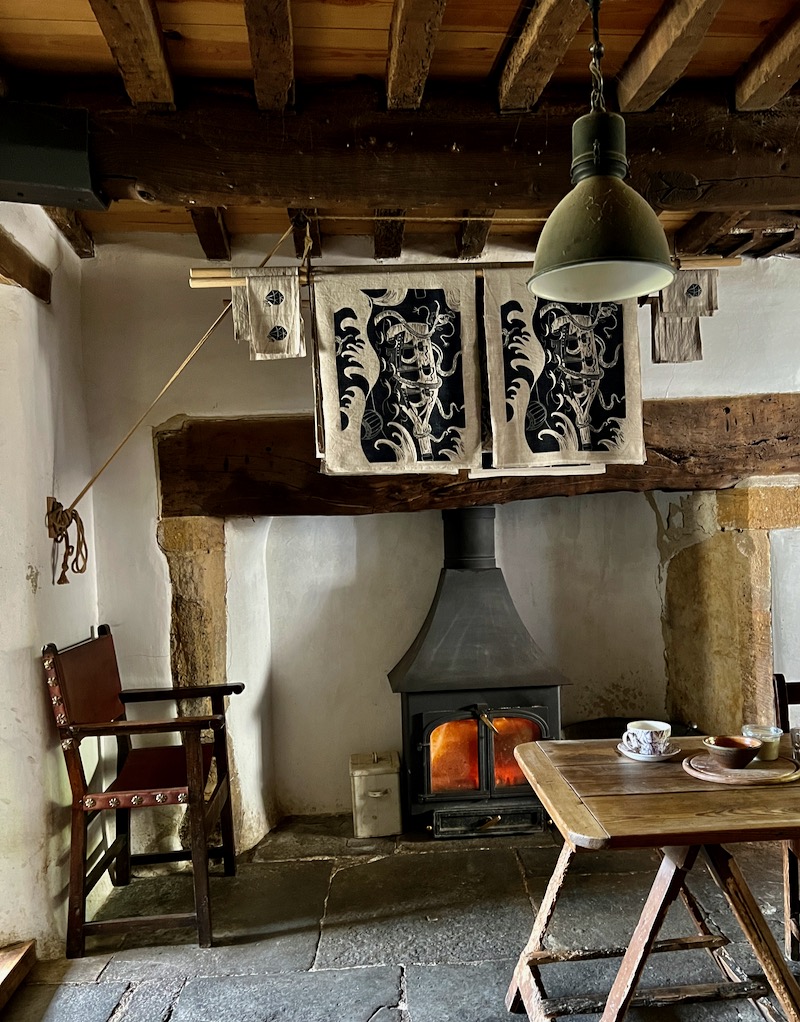
‘We got married and did this place up. I thought, we’ve bitten off more than we can chew here. We were overwhelmed…. We didn’t know that the blue lias stone floor was here, under a concrete screed and there were boards over the original floorboards and engine oil and petrol and paraffin drums everywhere..’ ‘Then one day we were pulling rubble and old plaster out of the chimney and we found a roll of notes! I was carting and dumping the stuff, it was a roll of old £20 notes , coal money from the 70s, then an envelope full…!

‘We found our way in the last few years, we’ve worked more and more with textiles’ Ship in a Battle print, drying.
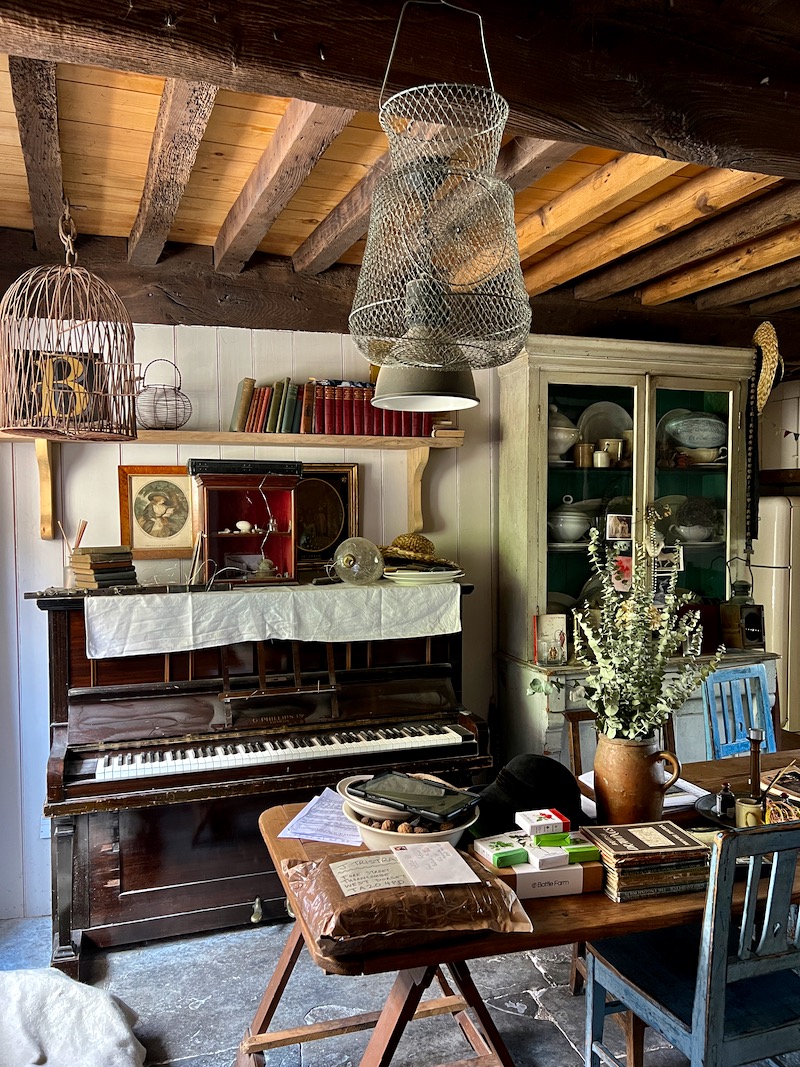
Day room

Cabinet of Curiosities on the piano

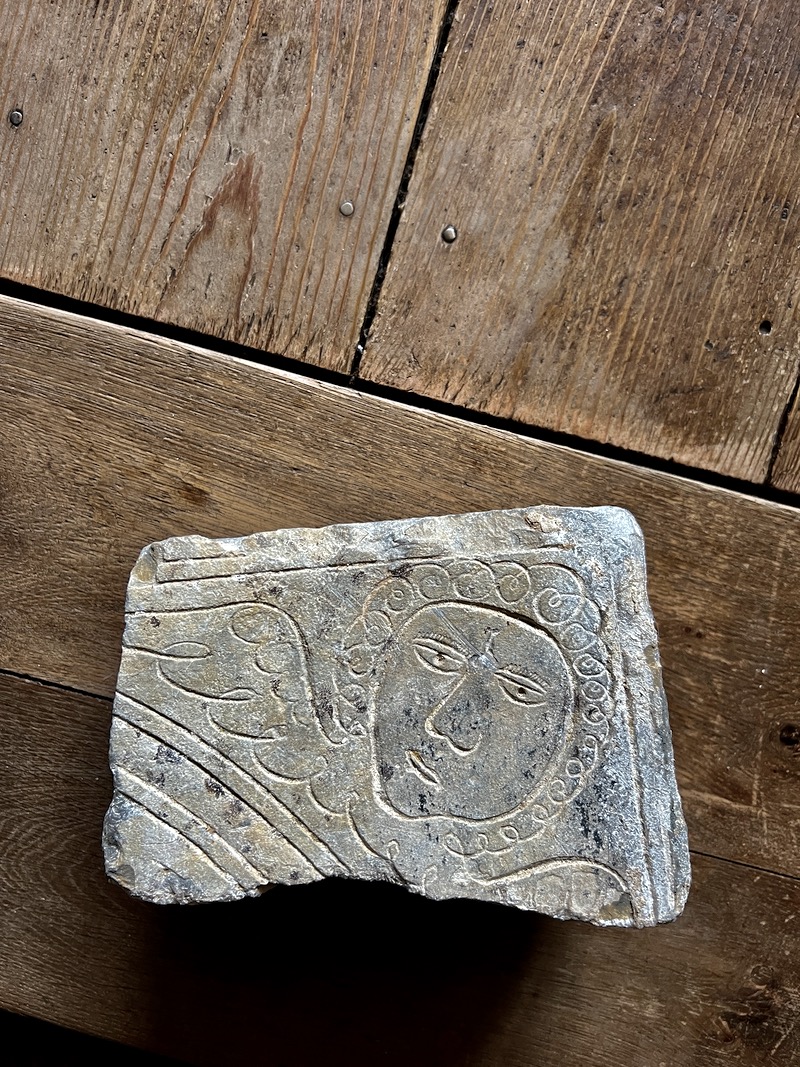
‘We found lots of curiosities. We found the old ‘Bonfield’ shop frontage sign, under rubble and old caravans…. Then when part of our gable end collapsed and we were rebuilding it, I was handing the stones up to the stonemason Gary and I gave him this bit of blue lias and – an angel fell out of our wall! We think it must have come from an old gravestone, a ledger stone, because the original Thorncombe church burned down so the stone may have been reused’

‘There was so much to do here! Outside everything was under earth and derelict, there was no drainage. Cameron put the cobbles in the yard outside down by hand. ‘ ”And we had to make decisions at 100 miles an hour and there are some things I’d have done differently. But it gives it a realness. I’ve since leaned that perfect is unhealthy. Perfectionism is unreal, it doesn’t have to cost money, it just has to feel right.’

Workshop on the left
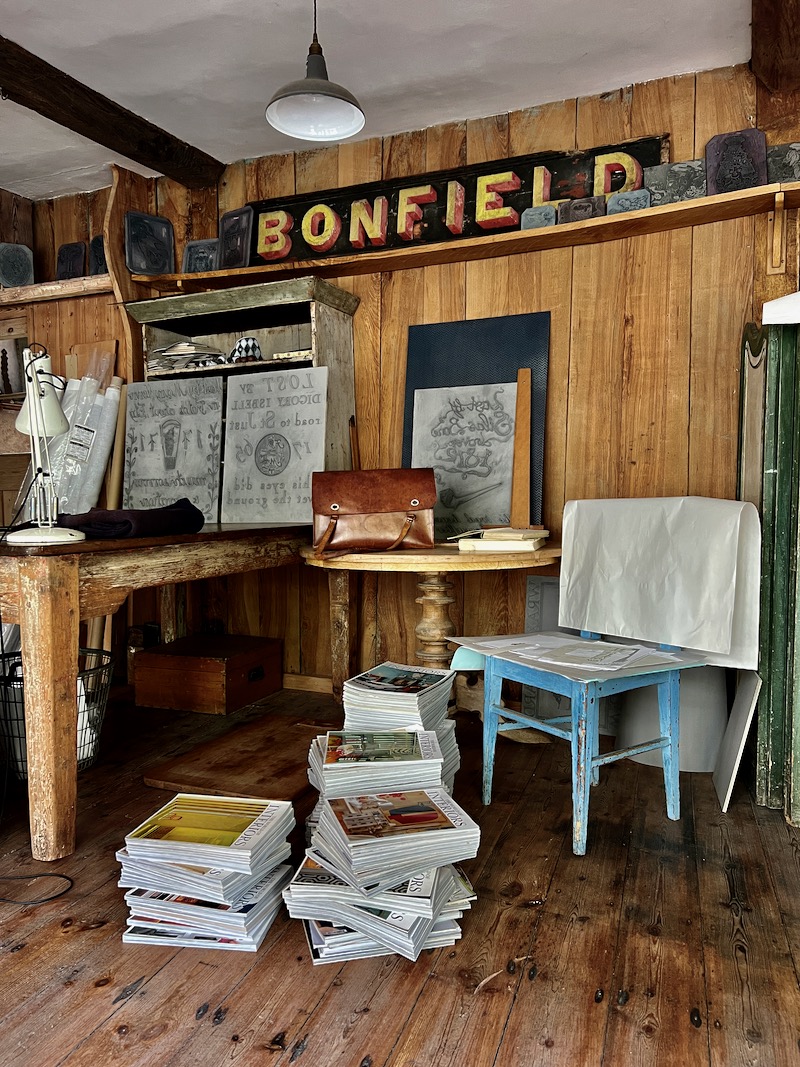
‘I grew up with a builder father and we were always renovating and restoring houses. It started percolating, I read an article in The World of Interiors back in 2005 and I think I was looking for a way out of advertising then, and I came across an article on Marthe Armitage. I thought, This is wonderful! It was applied art, not just a print on a wall in a frame. That struck a chord. I started thinking about print making. I used to draw all the time when I was a kid, I’m not formally trained but I’ve absorbed a lot, I love words, I love typography. It came about more by instinct.’
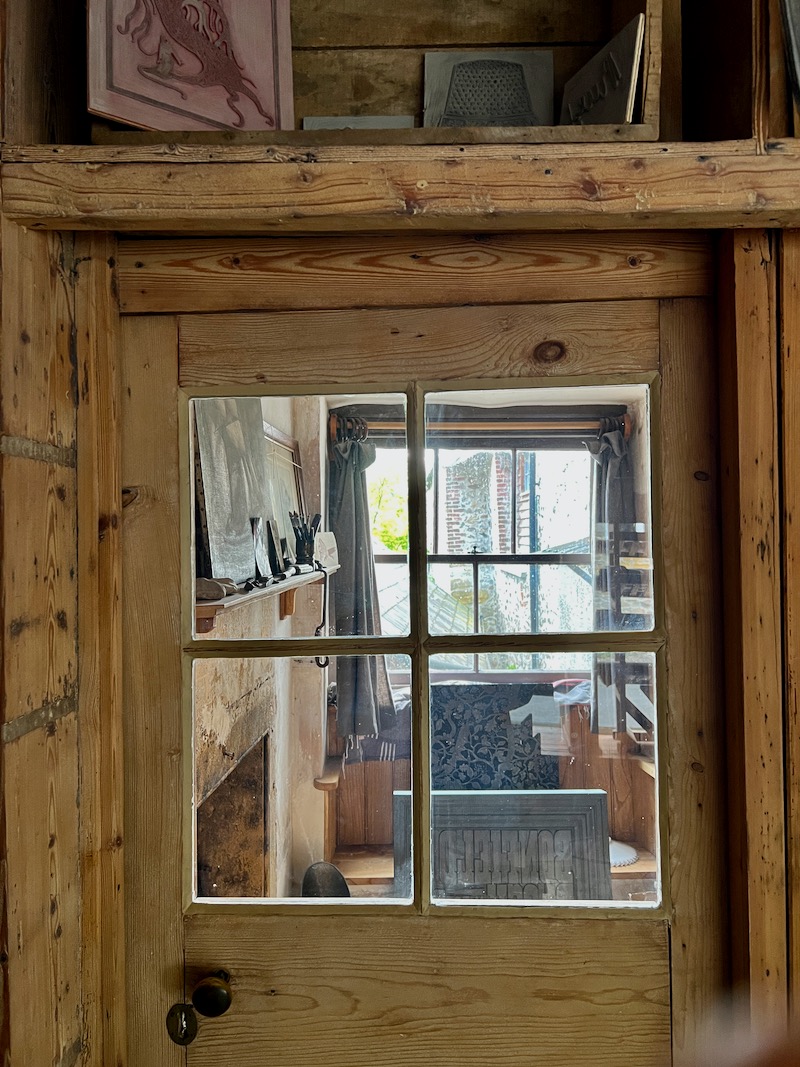
‘The next thing was me carving wood blocks and lino blocks in the evenings, having come back from working on a building site.’
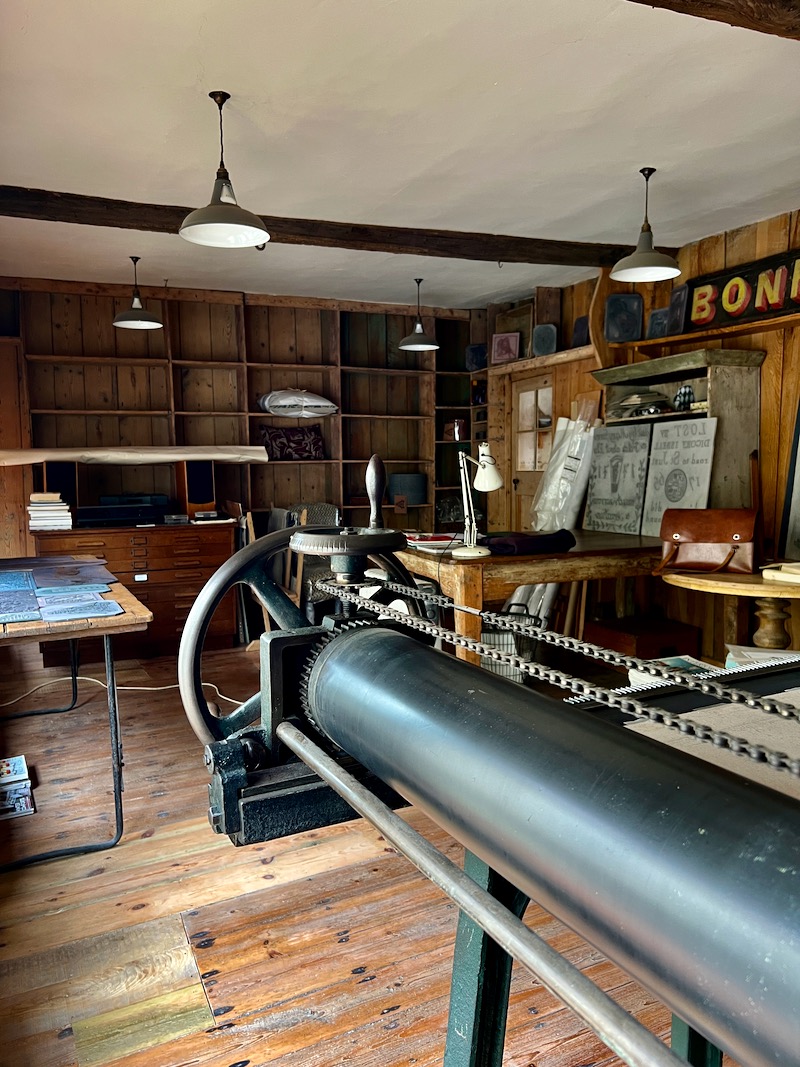
‘And then I started to think beyond wallpaper I did try for a bit but the press we have is an old proofing press, it’s not suitable.’

‘Bloodlines’ in blue-grey, fabric length

‘With an offset litho press, the block is fixed in position face up and you just ink it once or twice and you’ve re-inked the entire block and then a roller passes over the block and picks up the image and registers itself on some paper – Our press, we have to take the block away, ink it up, take it back, turn it over, place it down, roll a roller over to exert the pressure, and then take it away and re-ink it; it’s a much slower process.’

I put the block on an old bread board and press loads of Interiors magazines on top of it to get it perfectly flat again, so it’s not bowing or warped. once I’ve read it, it goes in my pile. I picked up a lot from Marthe on how to approach a design – repeats, that sort of thing. But I also had to learn a lot myself and make mistakes.’ Linocut for Trasure Tree.

‘Walking the fields with Janet ,we find things occasionally and we started thinking about lost objects their emotive nature…the soil holds a million secrets; fragments of past lives which have a potency. – Our latest work – four large blocks in all – celebrates this invisible archive, telling the story of objects lost by folk on the old roads, tracks and byways of rural England. .. a thimble that was lost on Romney Marsh 1880 – ‘ She did rue it .’
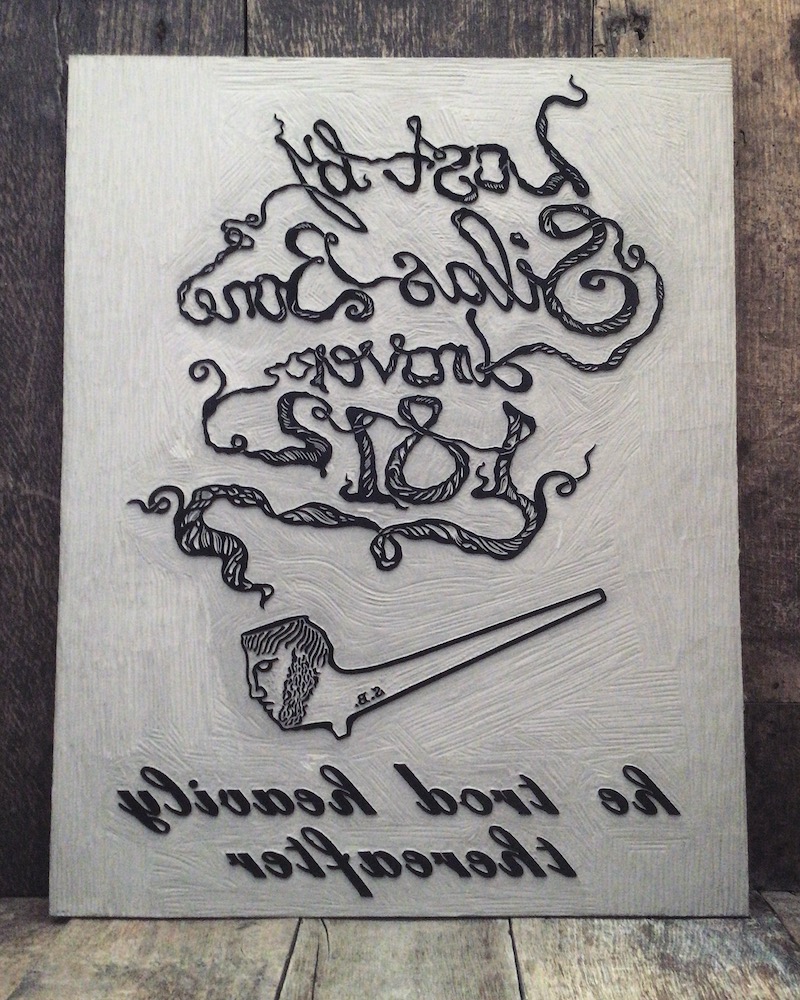
‘… these lost items are of an ordinary, everyday kind but this doesn’t diminish their worth. They are – or should we say were – significant possessions due to their beauty and sentimental or utilitarian value. A thimble, a clay pipe and a humble comb strike a chord because of their familiarity and helpful or comforting nature.’

‘A talisman or amulet – a more unusual, deeply personal artefact – resonates differently. Importantly, the stories speak of a time when because people owned less, their belongings meant more; to lose something in the C18th or C19th could be devastating.’

‘ This is a whalebone comb with a ship on it, I was carving that in reverse, I think I just drew it on and cut it and thought I knew where the shadows would fall on the waves. I did it in about an hour. Cameron is baffled by the fact that I’m a lot quicker than he is. I probably take half the amount of time. He curses when he’s inking up my blocks, because there’s bits he has to gouge out, because they’re not perfect.’
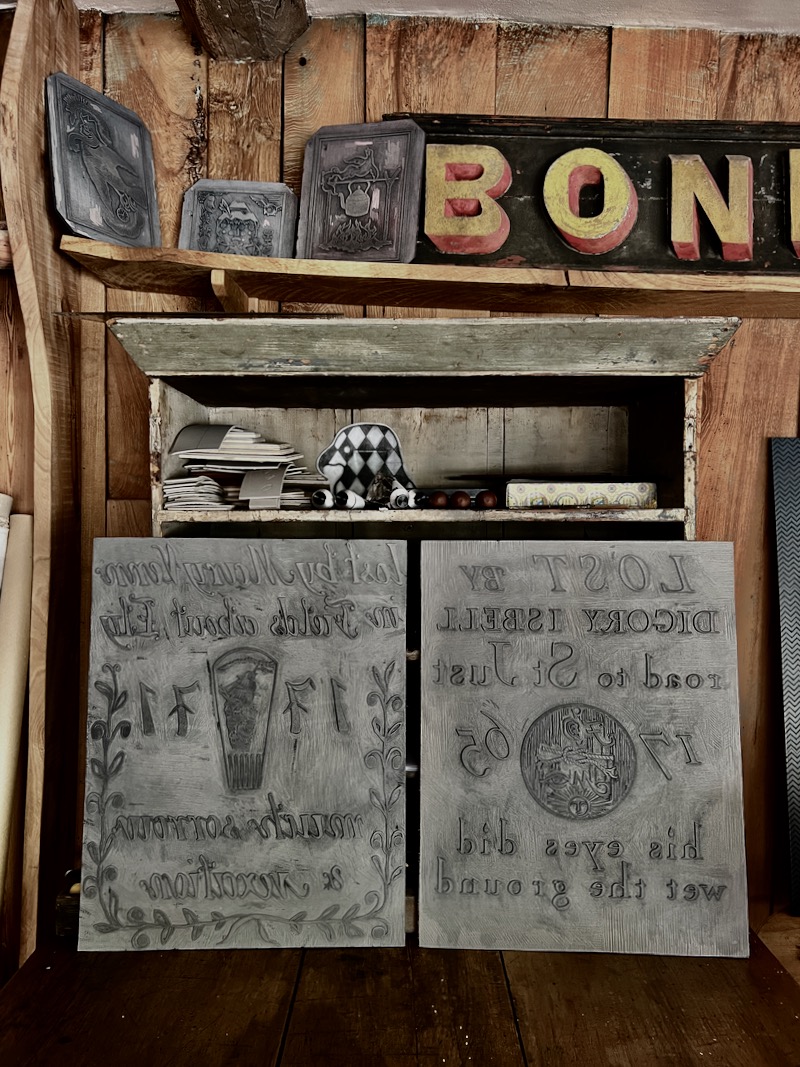
‘It’s cheaper to buy sheets of artists linoleum than it is, say, Japanese ply. There’s more block printing now – so many people are trying to replicate what Marthe does, I call it the fat chaffinch brigade! Consequently I feel our imagery has to be a little less cosy.
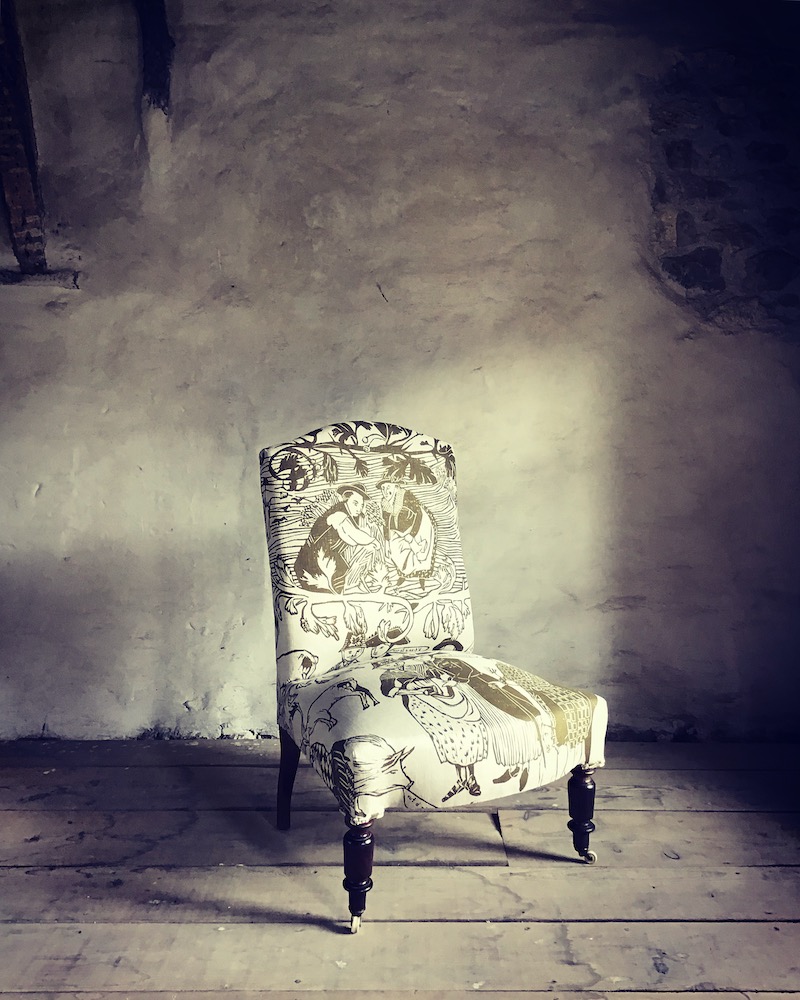
‘We’ve broadened our offering to all sorts of things, cushions for example. They’re one hit and they’re bread and butter items. Lampshades and upholstery. Furniture, picking up simple historic stuff get them done properly with horsehair.Garments. It’s nice to see your image on a three-dimensional object. You can almost print on anything. When we started garments, it wasn’t really in the zeitgeist – the Poacher’s Coat really started something.’ Napoleon III Slipper chair in ‘Lyme Bay,’ hand printed linen.

‘We divide the load and in the last few years I‘ve worked more and more with textiles. Cameron tends to ink up the blocks because he’s much more fastidious – his are better but we both cut. The difference is typography, Cameron understands layout – his layout is so much more classic and perfect and his cutting is beautiful, he’ll use a ruler.
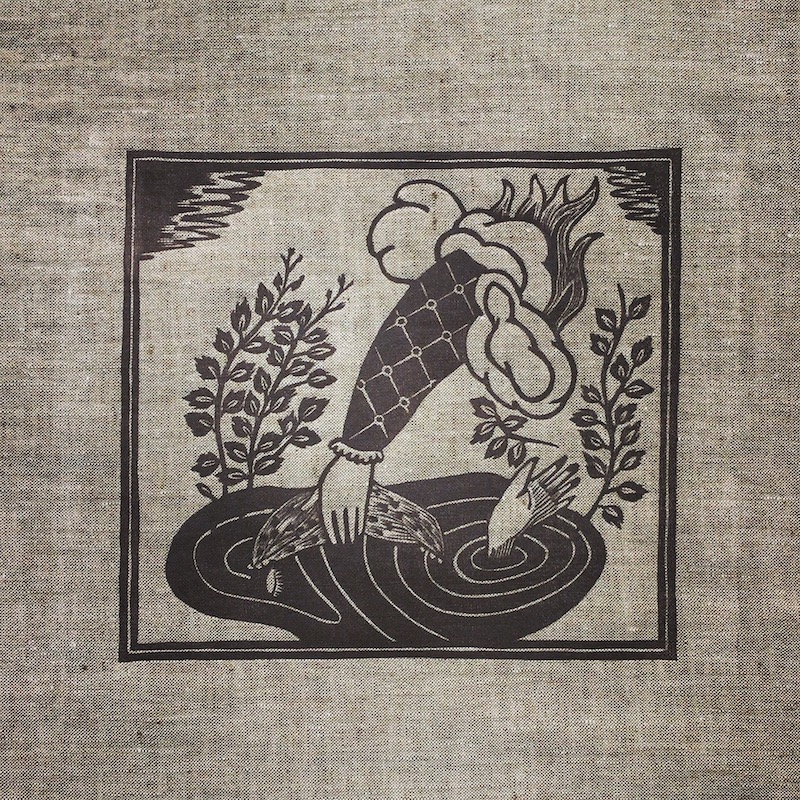
‘This was a Somerset Song Coat – that’s mine. Mine’s more fluid, I’m a bit more haphazard, I’m more sketchy. I do it by eye. We often say it’s amazing we work together pretty much in harmony, but he has learned to deal with me because I will not measure things out. That’s kind of masculine/feminine in a way.’
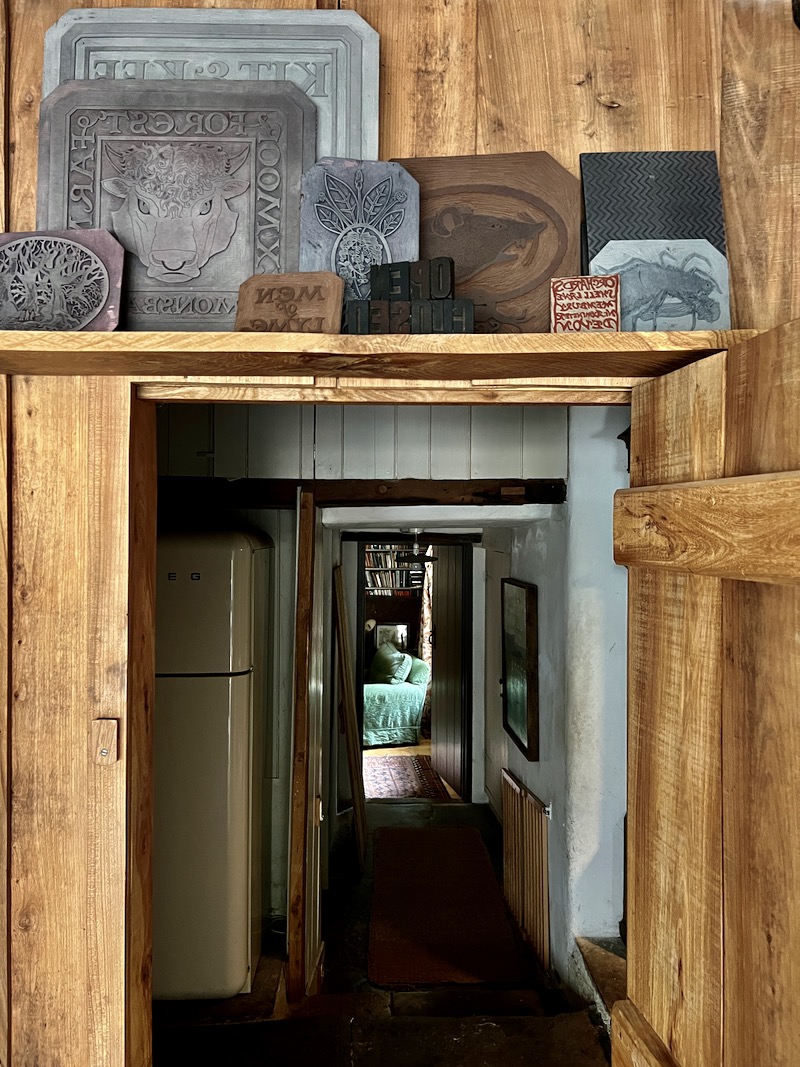
‘These are ours, we both do logos. I’m more of a cook than he is. I’ll be the one that stops to cook a meal, he’ll be the one that does one thing well. I do a multitude of things fairly well. I’m from a different culture, I’m not British, not brought up in the same way, the same culture – that was difficult at first. I might be more relaxed, I allow him to be a perfectionist.’
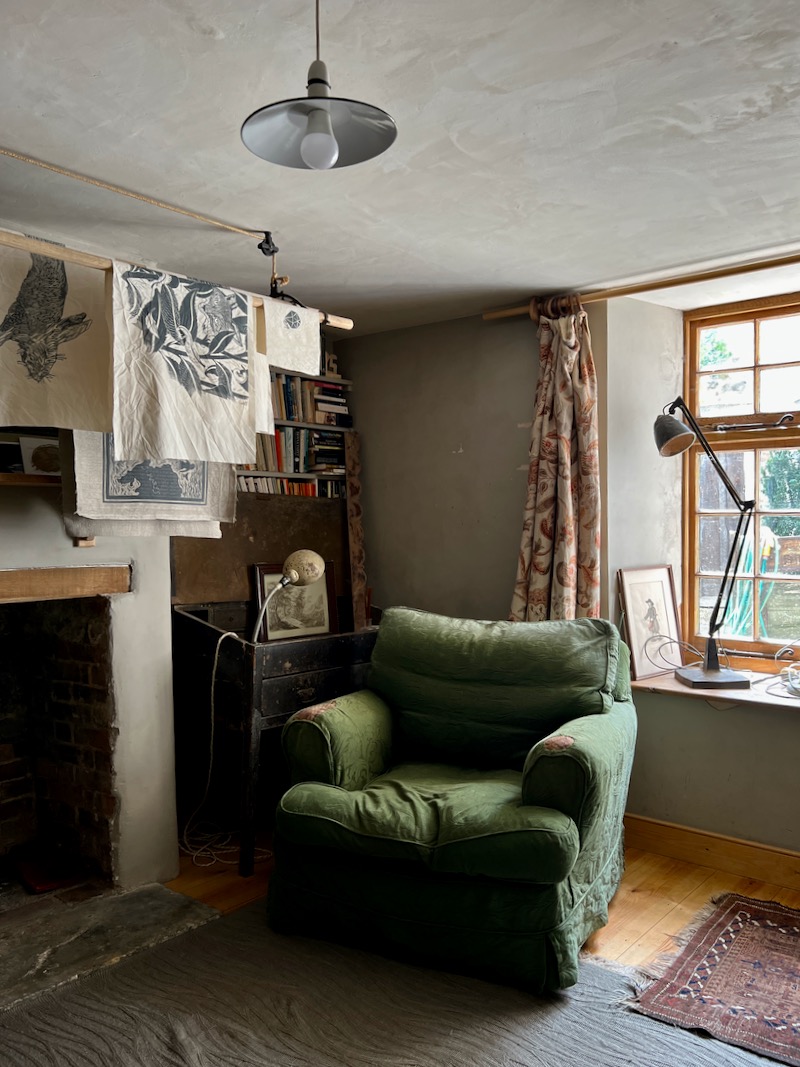
They met in a Soho, in a Berwick Street bar where Janet’s mother’s French boyfriend was barman. ‘We had a coup de foudre – we met by chance and we’re both ideas people and I studied printmaking at art school in New Zealand, where I grew up…’
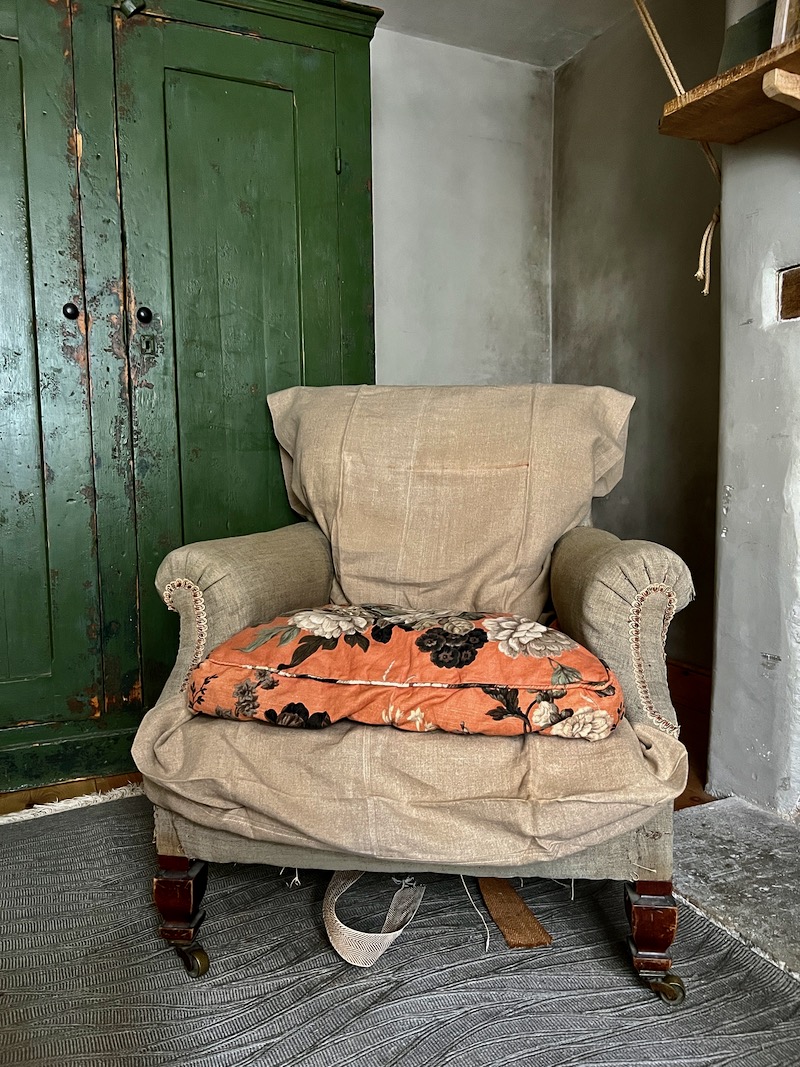
‘There was a photograph of this beautiful girl behind the bar. I asked Patrick and he said, She’s far too good for you – it was Janet. Then one day I walked in and she was sitting at the end of the bar. That’s how it started. Meeting Janet – she saw something in me – made all the difference.’

‘I encouraged Cameron to leave his job, so we went to that ratty old farm.’ – ‘I was suddenly working on a building site as a labourer aged 38 – it’s good to be outside. I learned some things and met some people who’ve helped me. And I started carving blocks. There was this lady we met, a boat builder, and she saw some blocks I’d been carving, said, You’ve got to apply for the QEST Scholarship, it might allow you to take some time off the building site.’
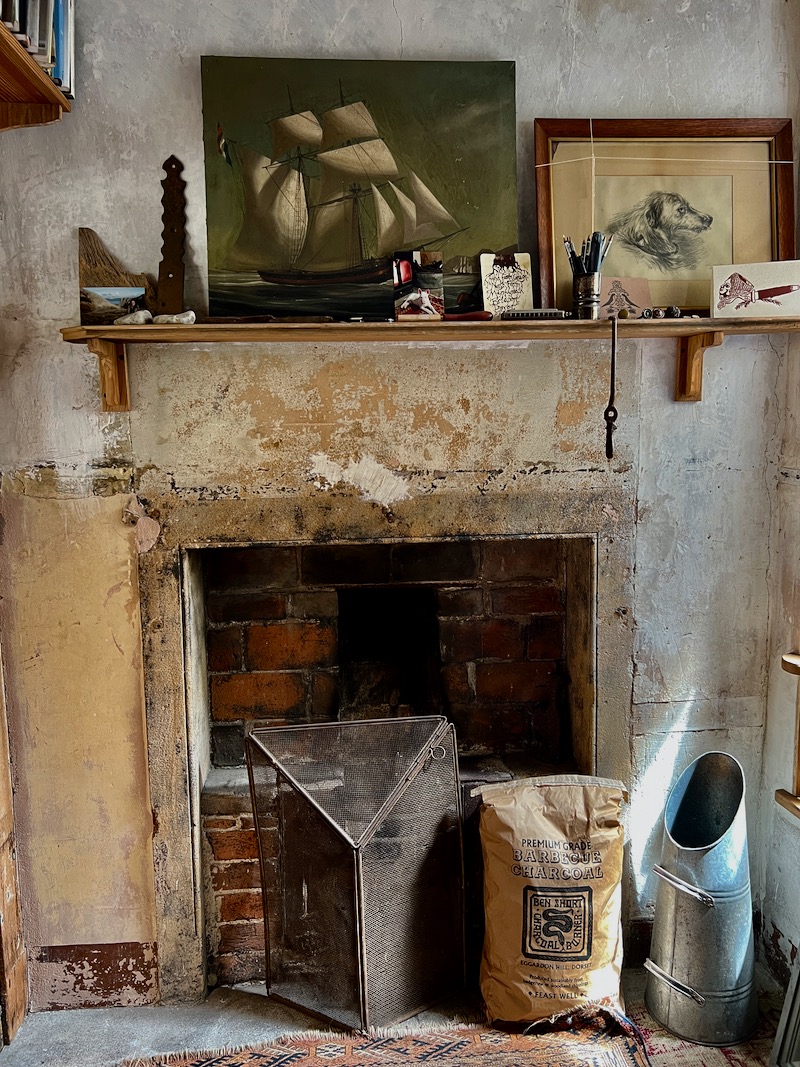
‘Cam did and won a scholarship!’ – ‘It’s for people of any age – you could apply for 18k for training or equipment. I did 2 days a month with Marthe Armitage, I got in touch with her via the Art Workers Guild. She’d never mentored anyone before but the time was right.’

‘My brother Ben painted this for me [Ben Short, author of ‘Burn,’], he had a furious painting spate. And then stopped.’

kitchen end

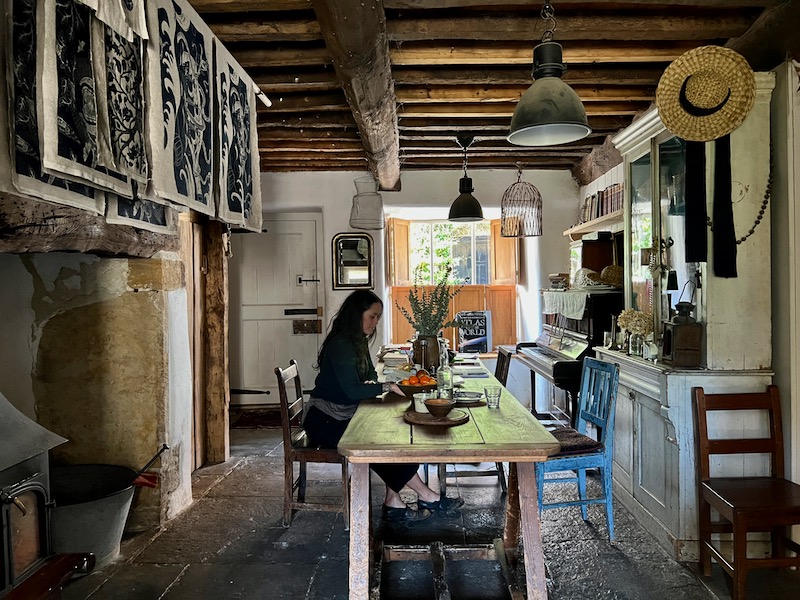
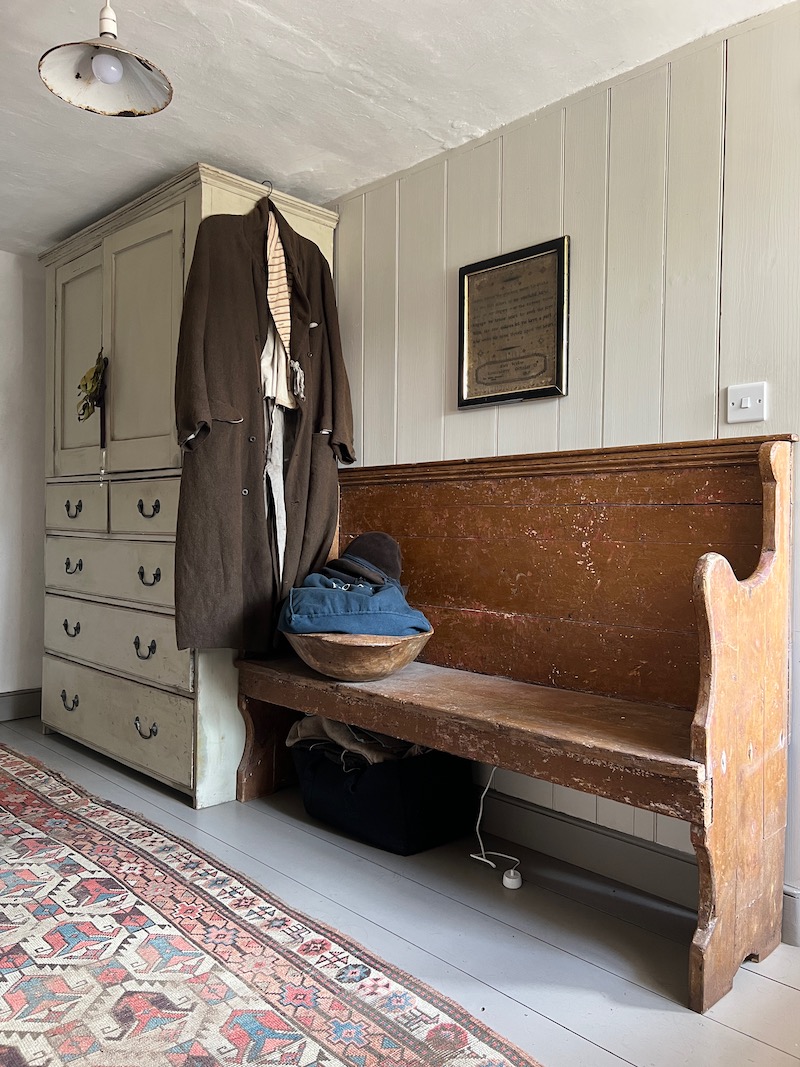
first floor landing
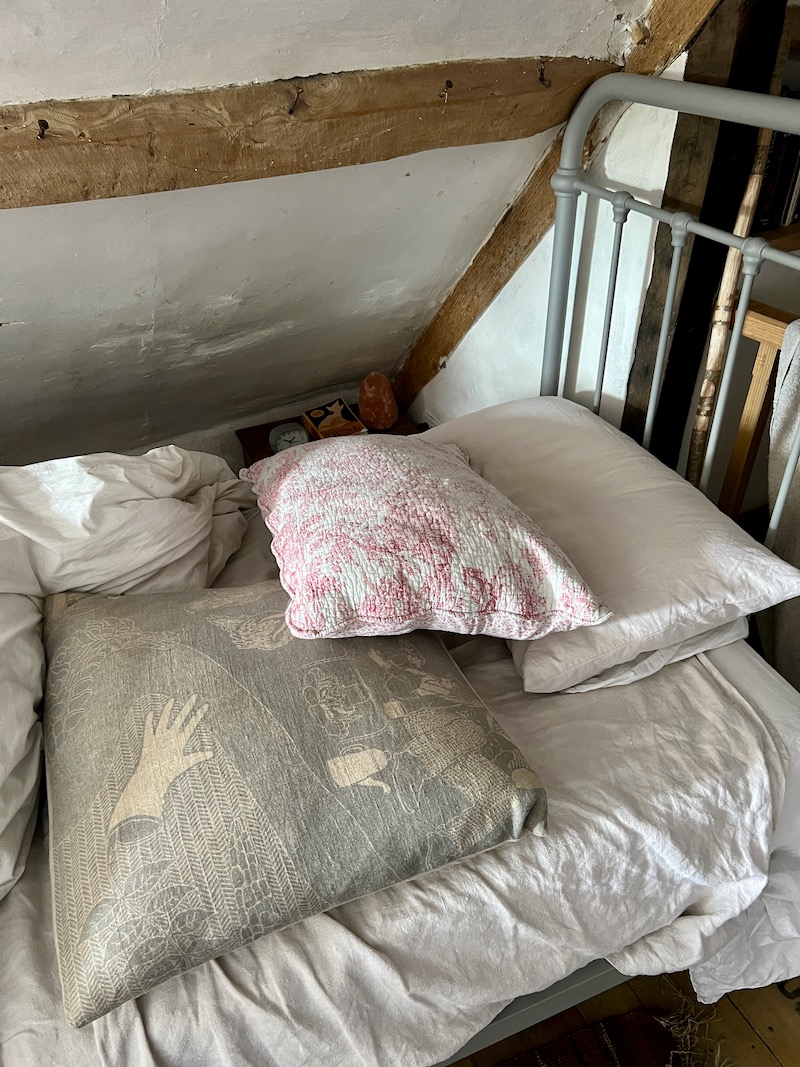
‘This is Ethel’s room, our eldest. The floorboards were patched with old packing cases.’ Cushion, ‘Ode to the Ash.’
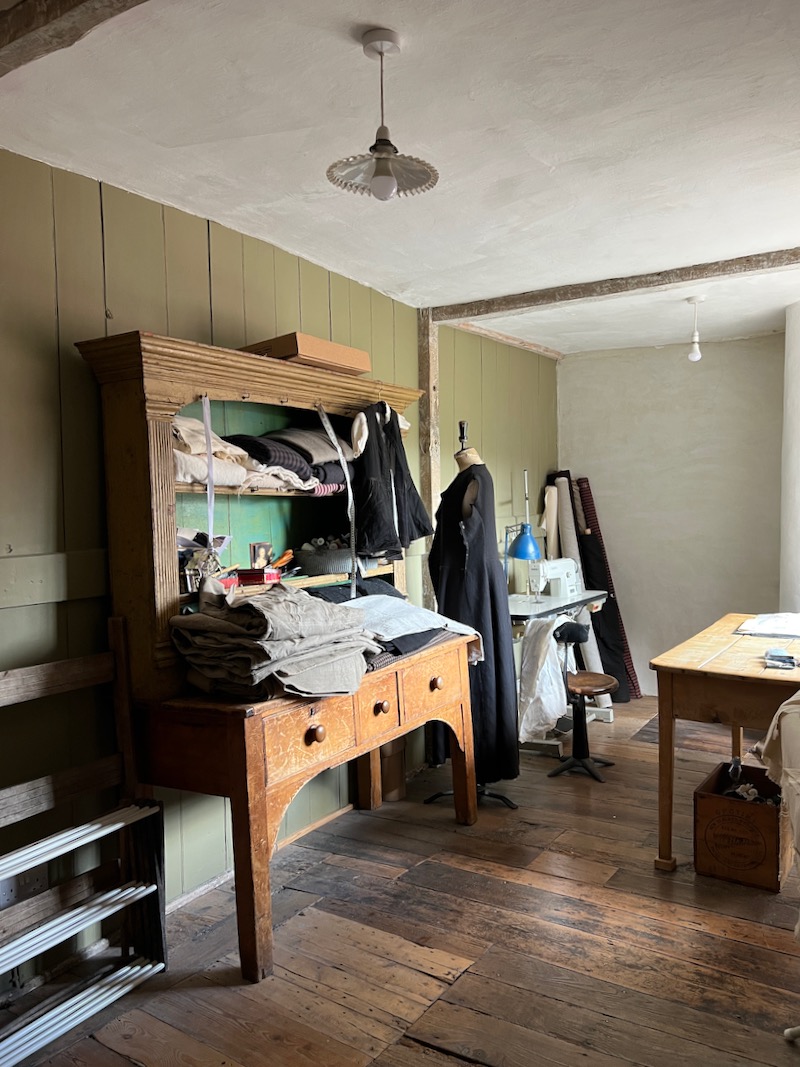
‘This is my workroom, it has a coffin hatch or old staircase of hamstone steps going down under the floor. There are signatures on the attic staircase, Bessie and Mabel, so perhaps they were the servants or workers here and the attic was their bedroom?’
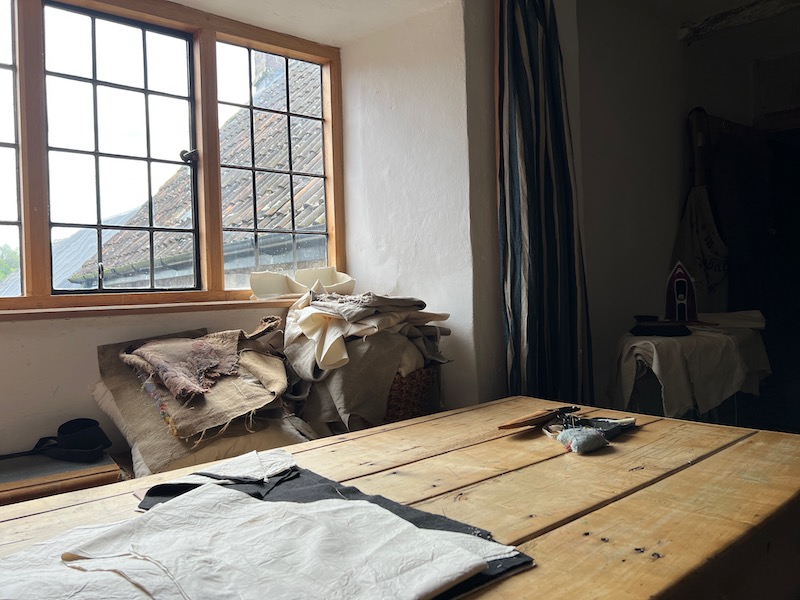
worktable

Poacher’s Coat in Harris Tweed
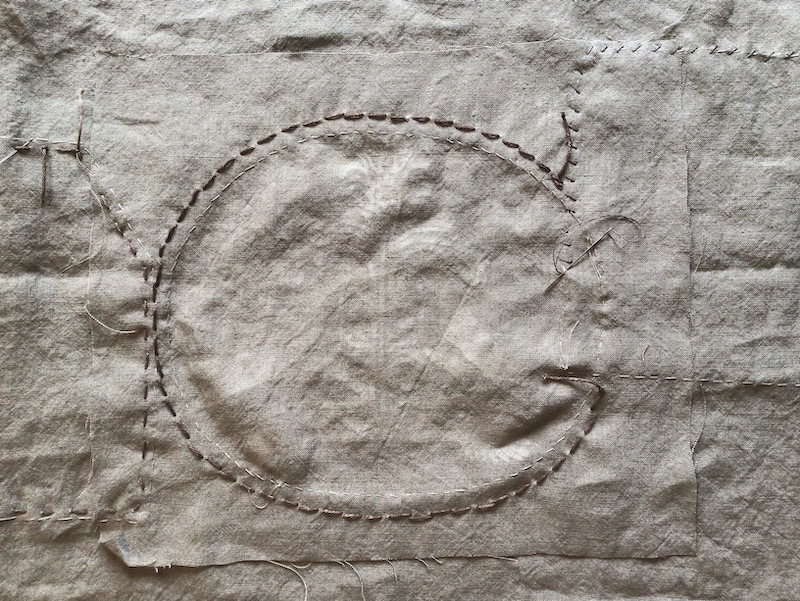
a patch
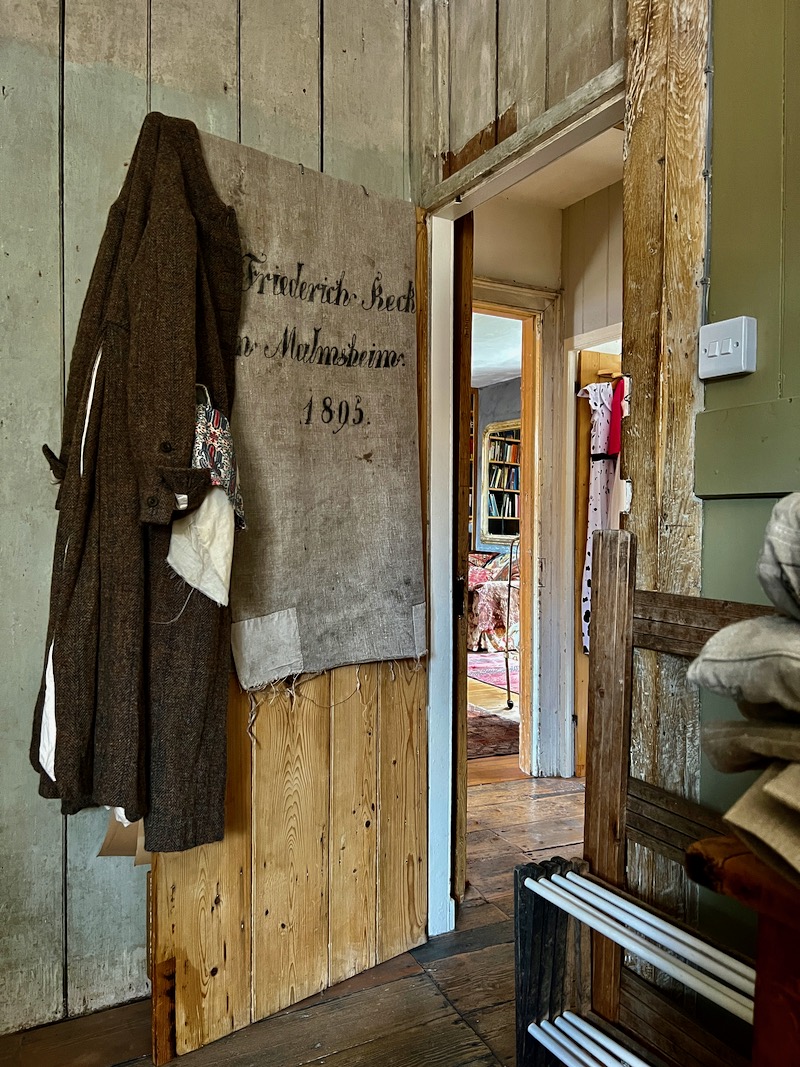
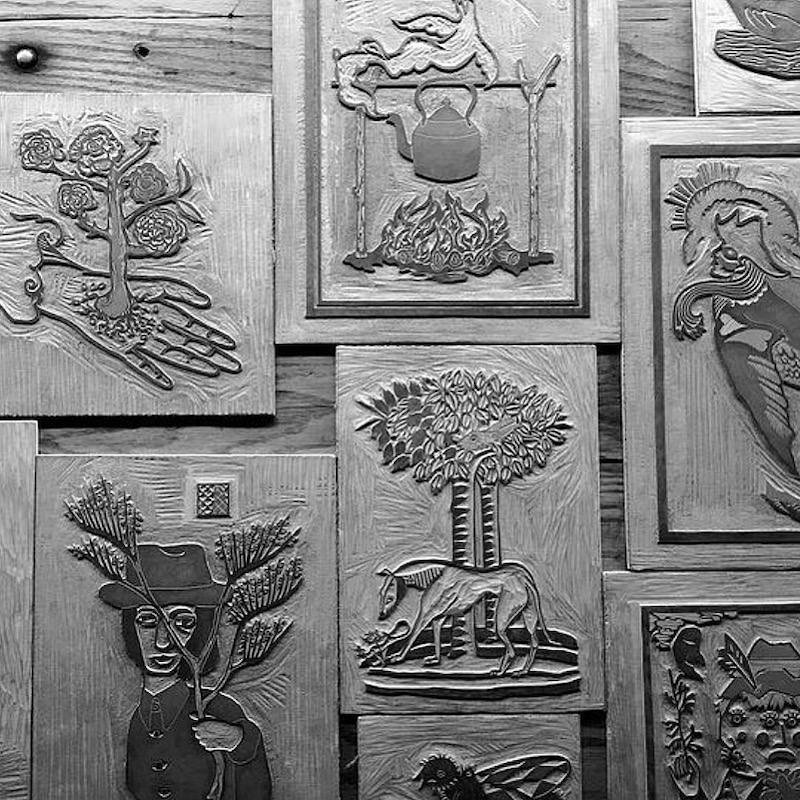
Block prints by Janet Tristram and Cameron Short for the lining of their Somerset Song Coat,, imagery from the songs ‘As I walked through the Meadows’, ‘Bruton Town’, ‘Green Broom’, ‘Sovay, Sovay’, ‘The Crystal Spring’, ‘The Seeds of Love’, ‘The Sprig of Thyme’ and ‘The Wraggle Taggle Gypsies, O!’

‘We’re going to produce more garments, ‘Lost Coats,’ with deep pockets, to keep your precious things safe, emblazoned with images inside and out.. Bags too.’
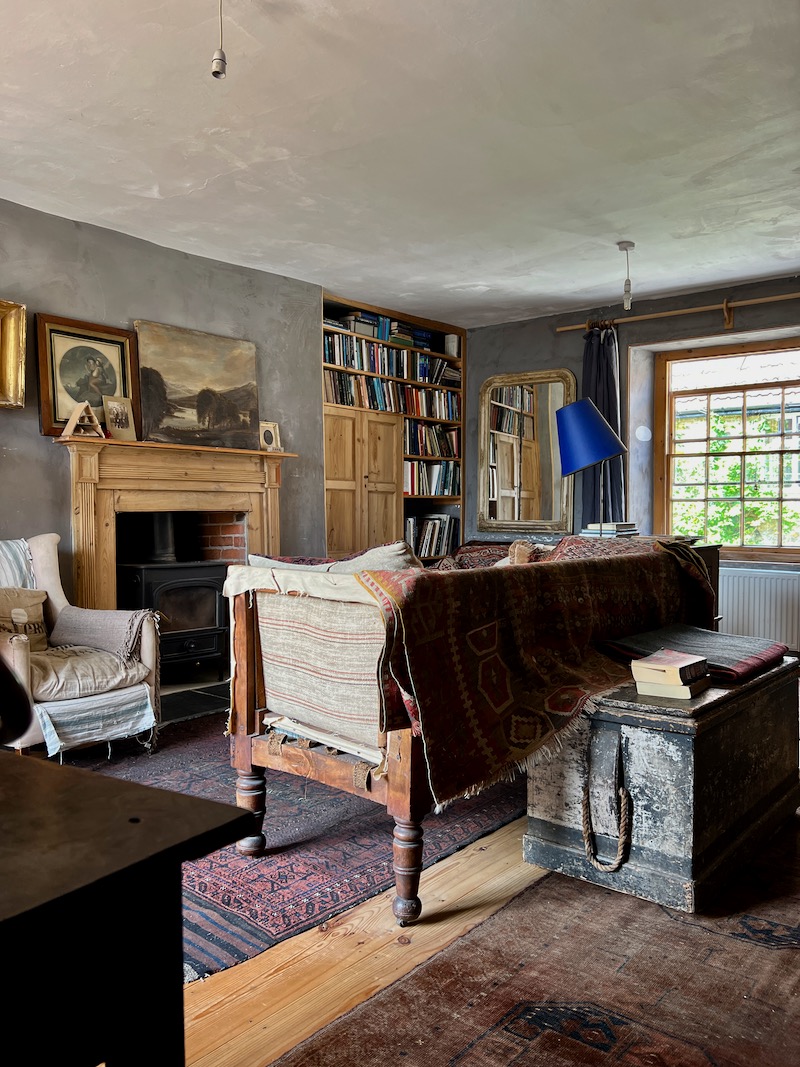
‘This room had what Cameron calls Donkey’s Breakfast woodchip wallpaper covering ever surface. A boy who used to be part of the Bonfield family remembers cooking Christmas dinner in here and his grandma had a bed in the corner, but fire had burned out all the floorboards.’
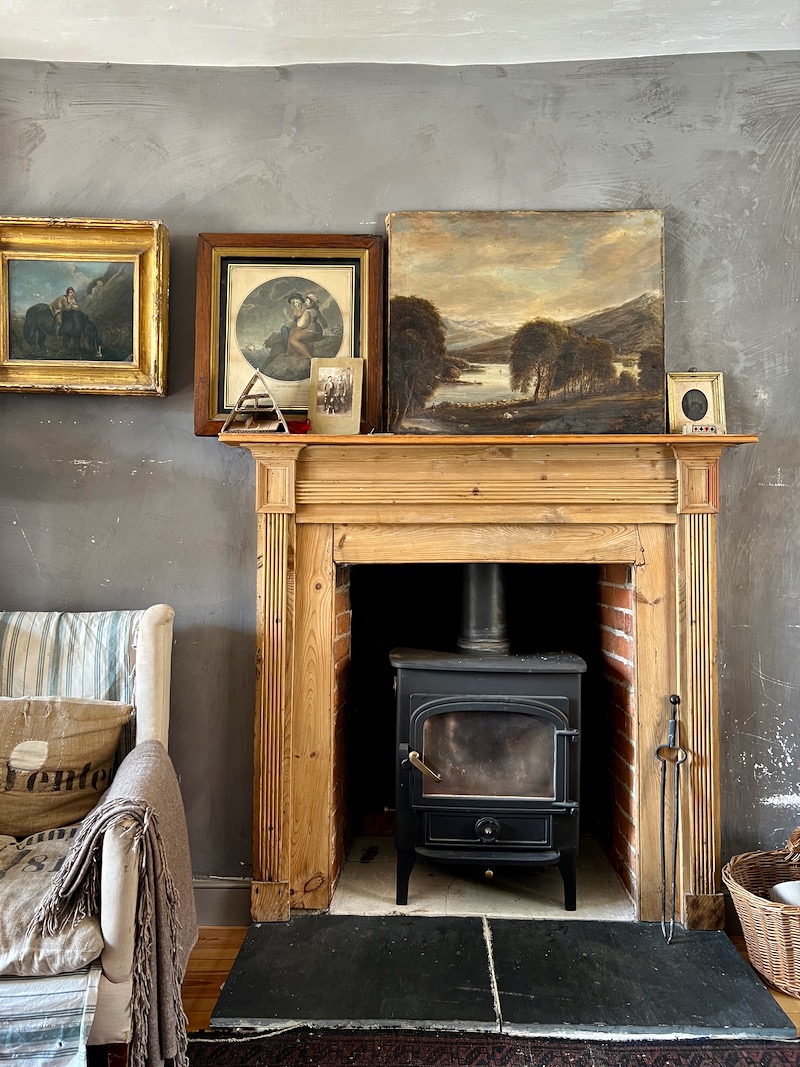
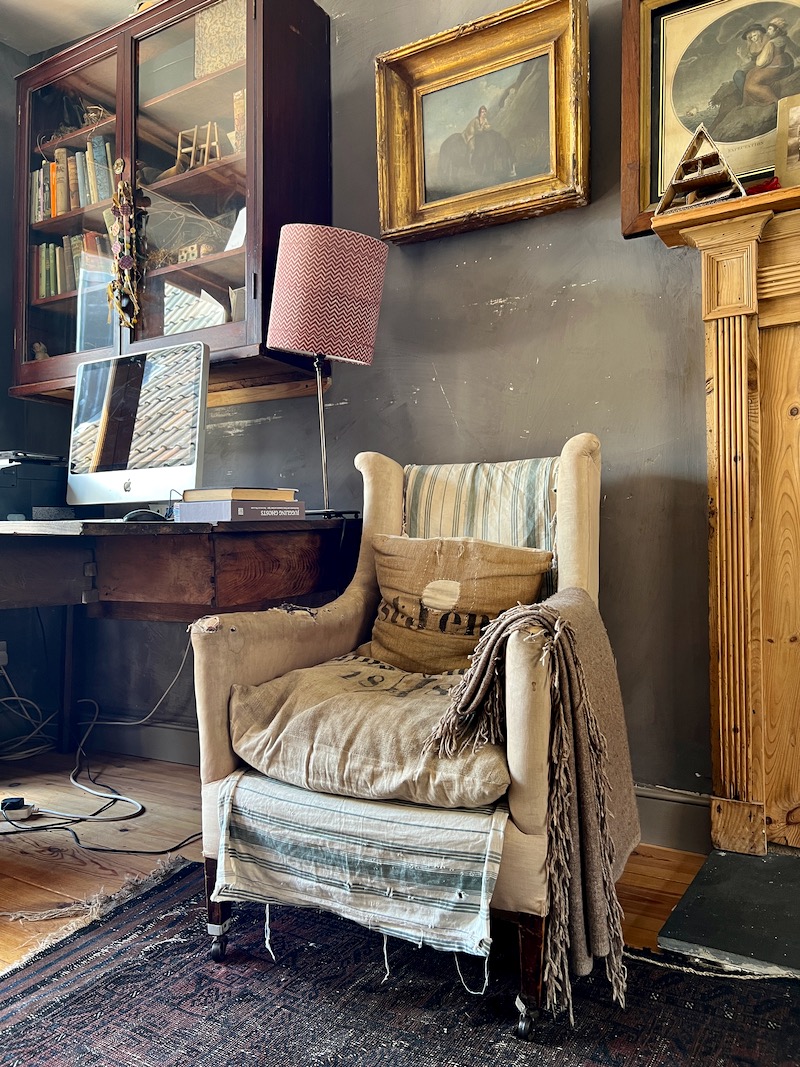
We found that gate-leg table in the wool store here and repaired it

sacking cushions
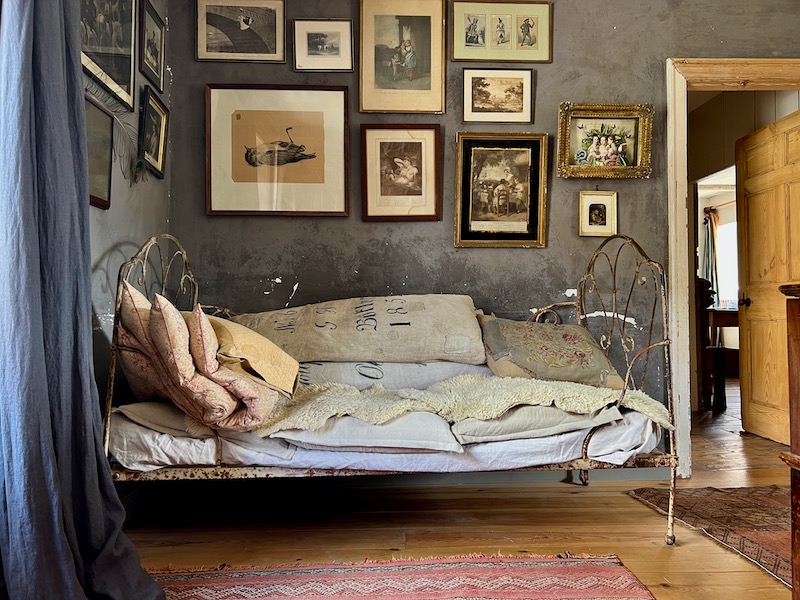
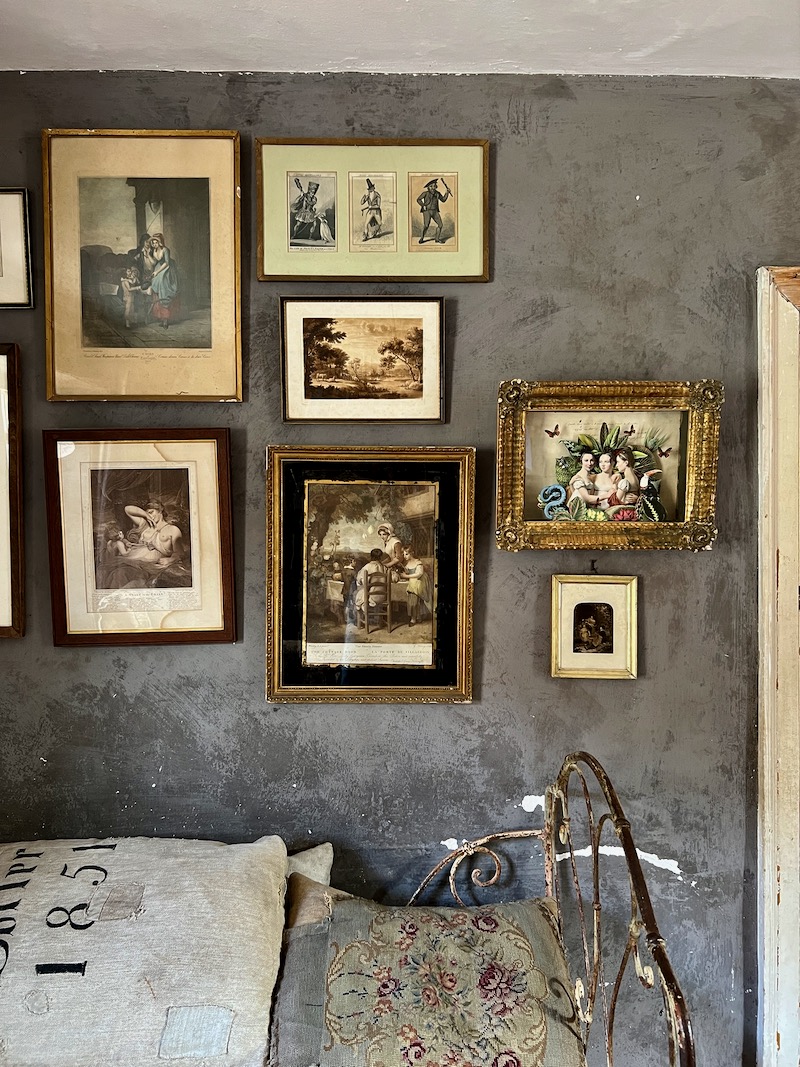
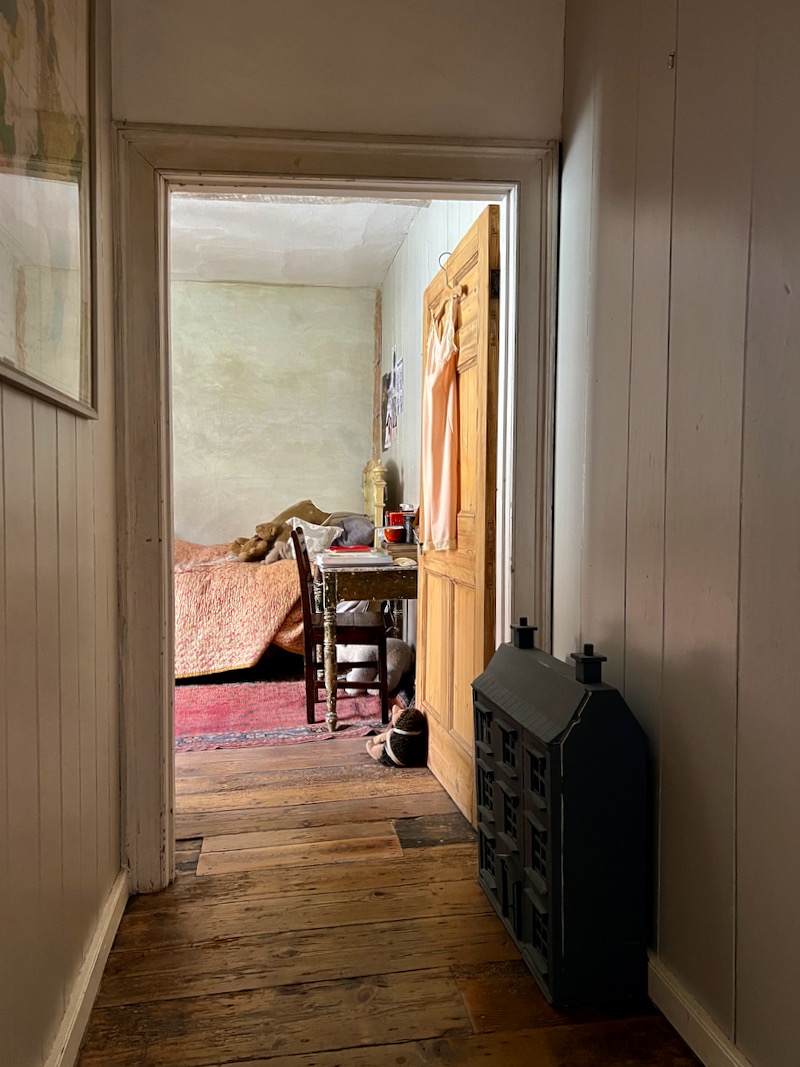
Zola’s room

ablutions
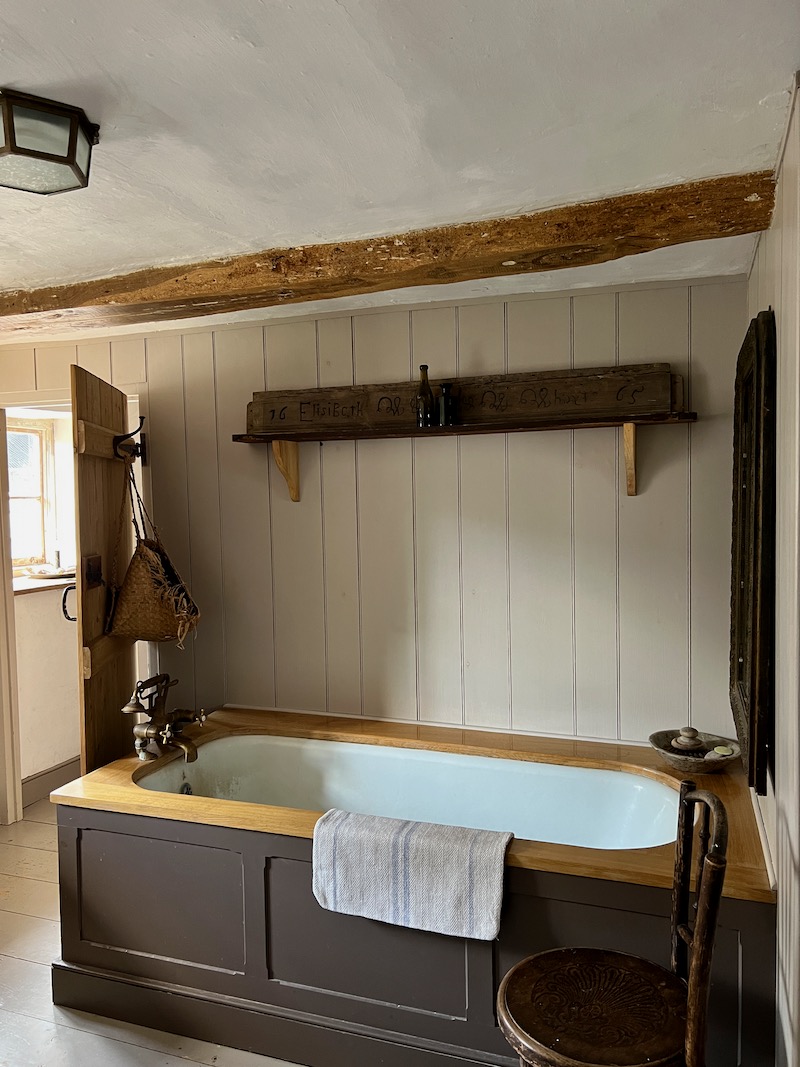

Their bedroom, in the attic

view from casement
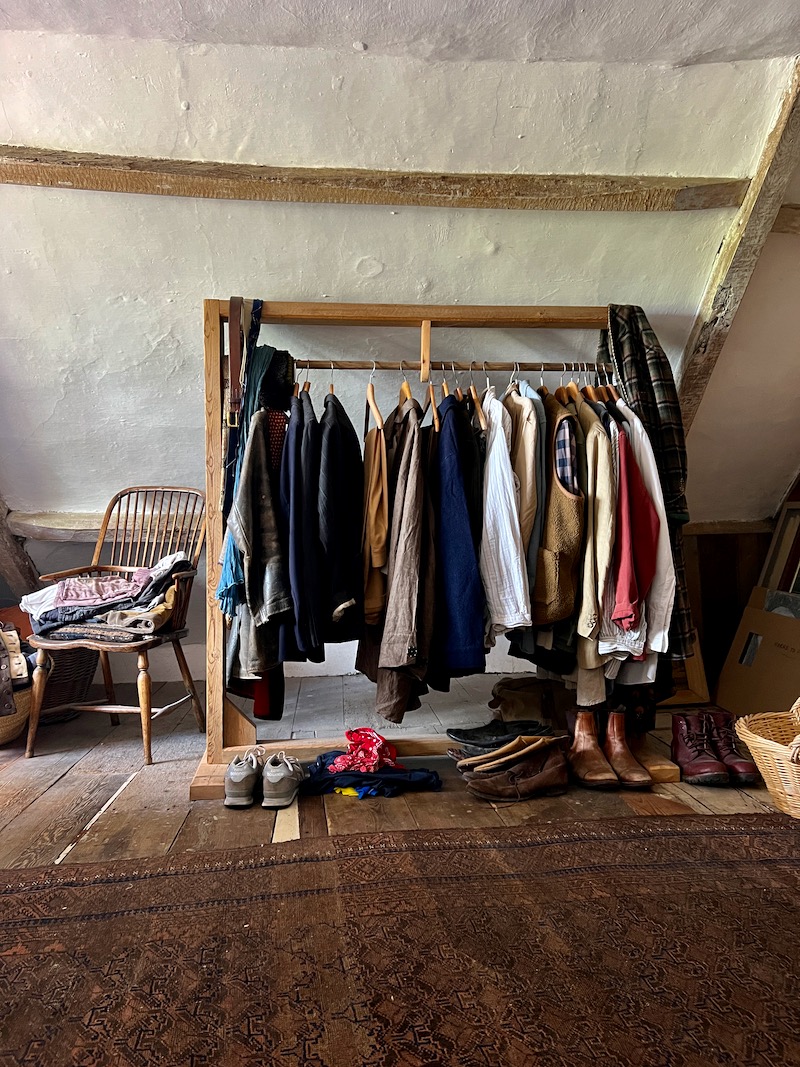
Clothes rial made in situ by Cameron, because the attic stair is too narrow for the passage of anything larger.
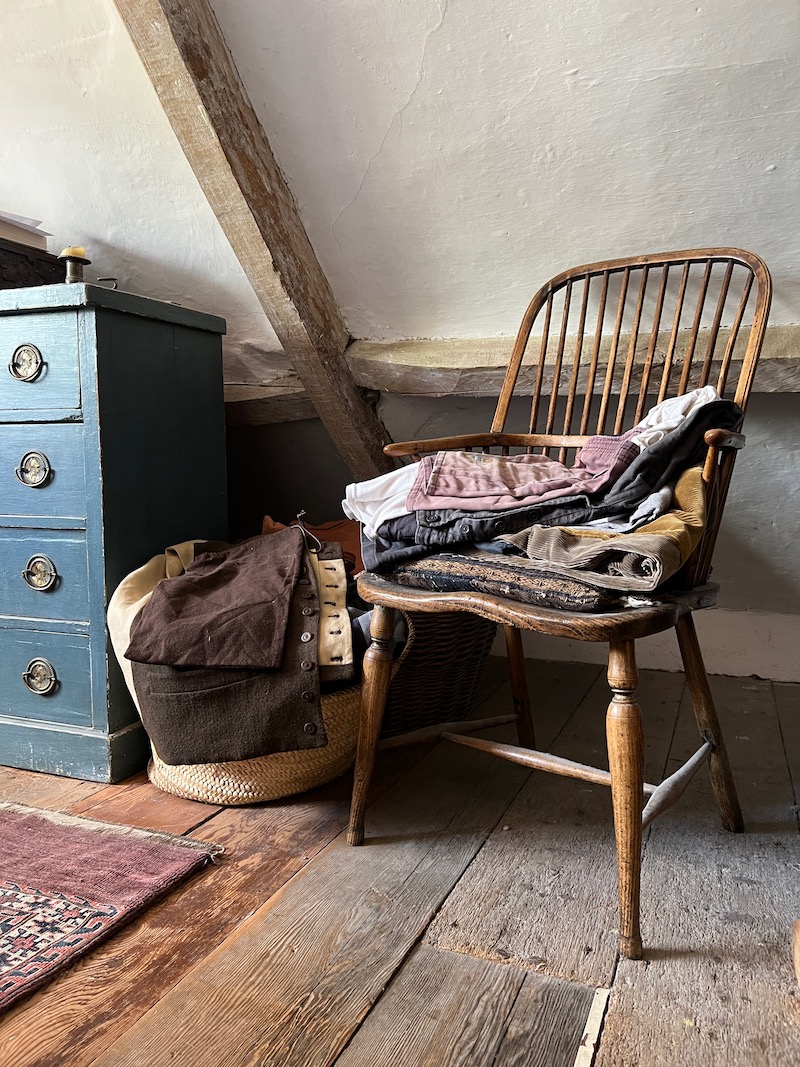
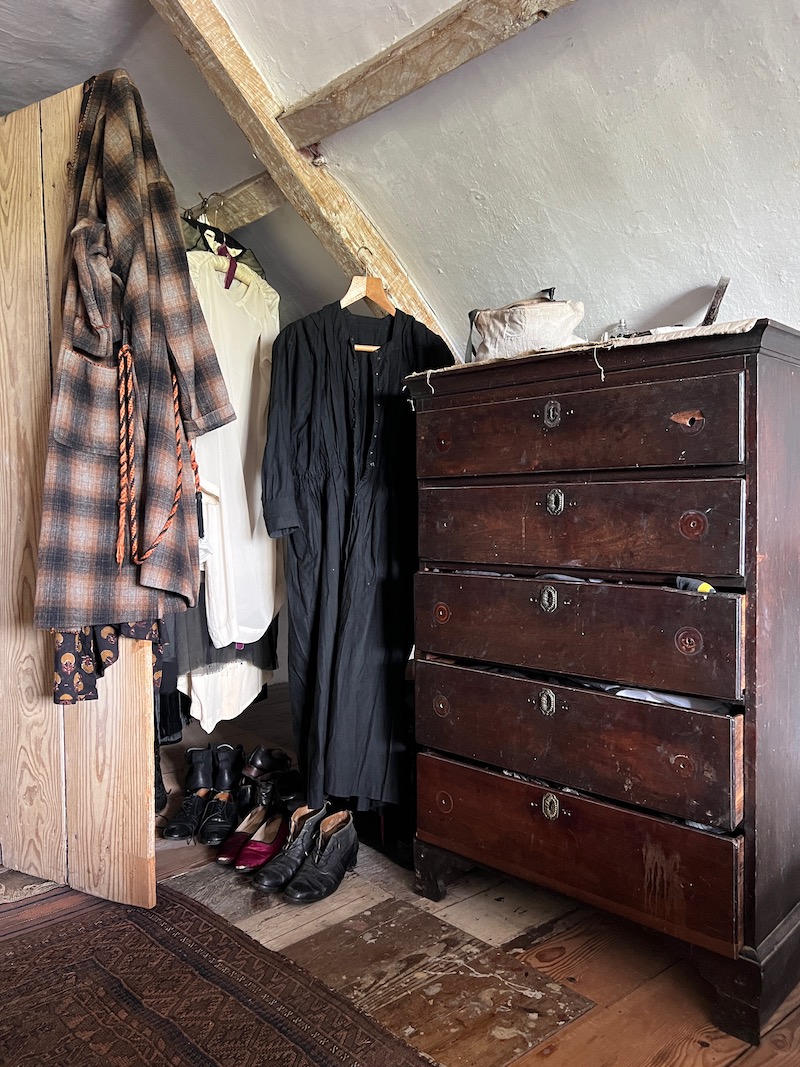
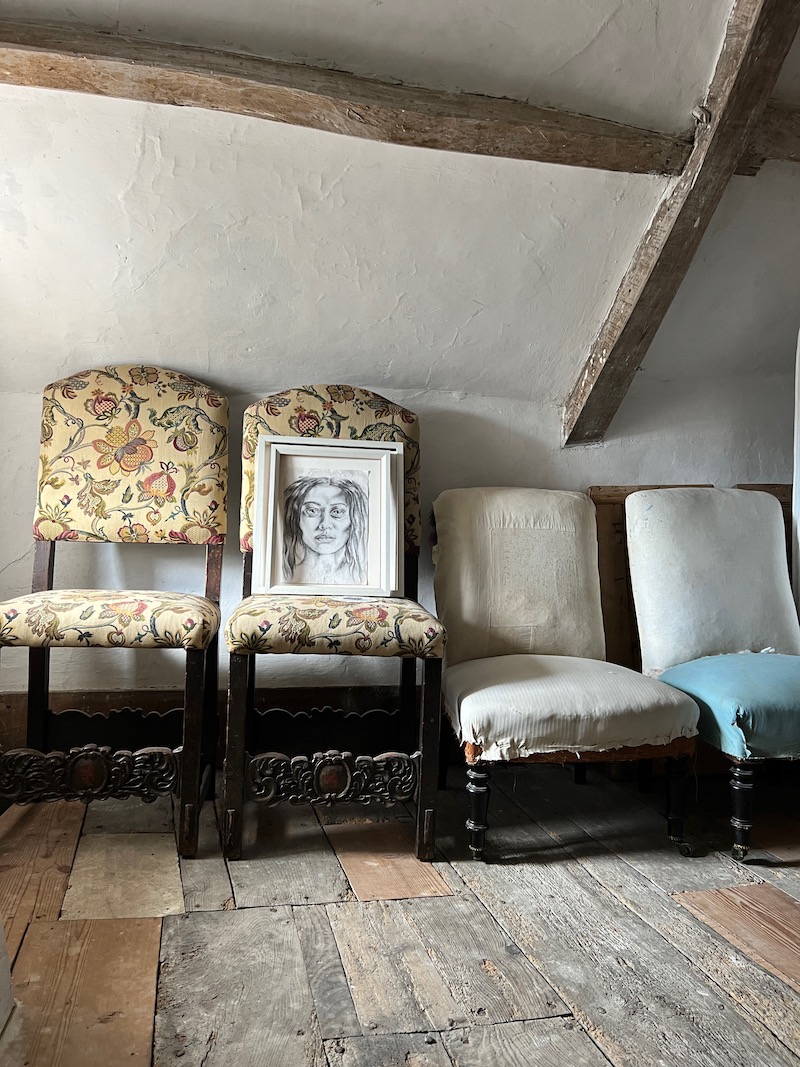
‘We’re going to get the girls bedrooms up into the attic, so they can play their music’ Janet’s self portrait, aged 14.

the backs
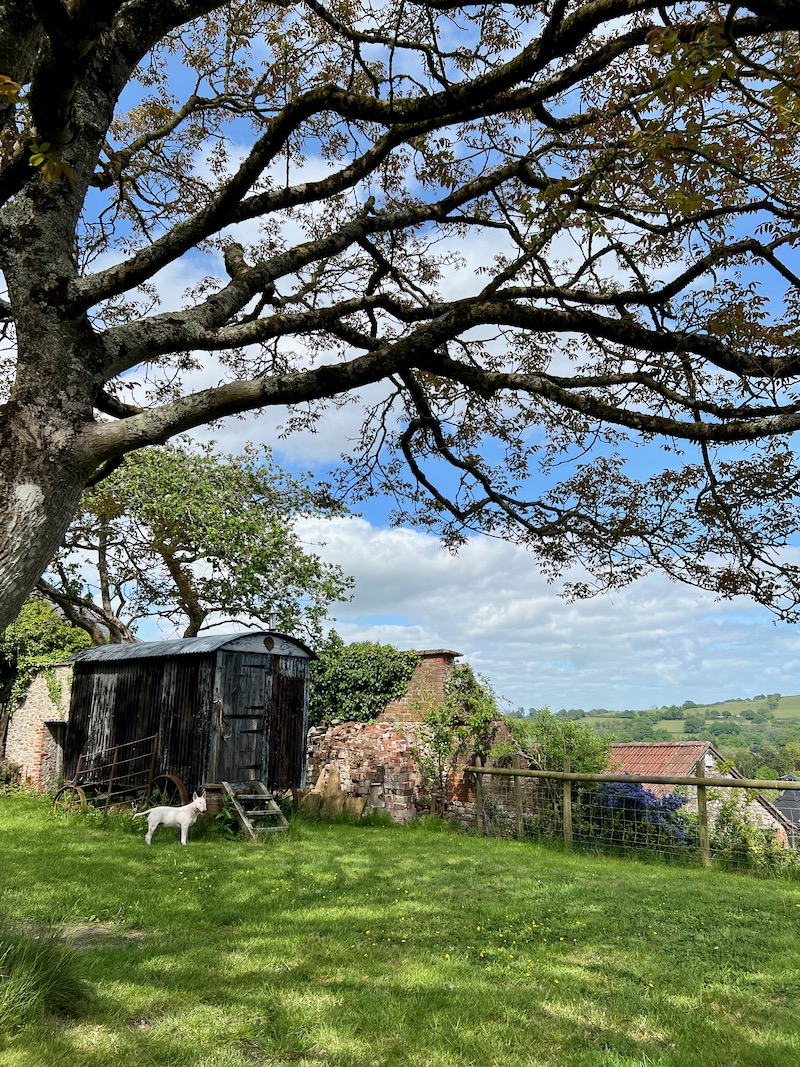
Queenie, bull terrier bred in Skelmersdale, Lancashire.

‘Cameron used to work in the shepherd’s hut when we were living at the farm, it was his only place to get away’
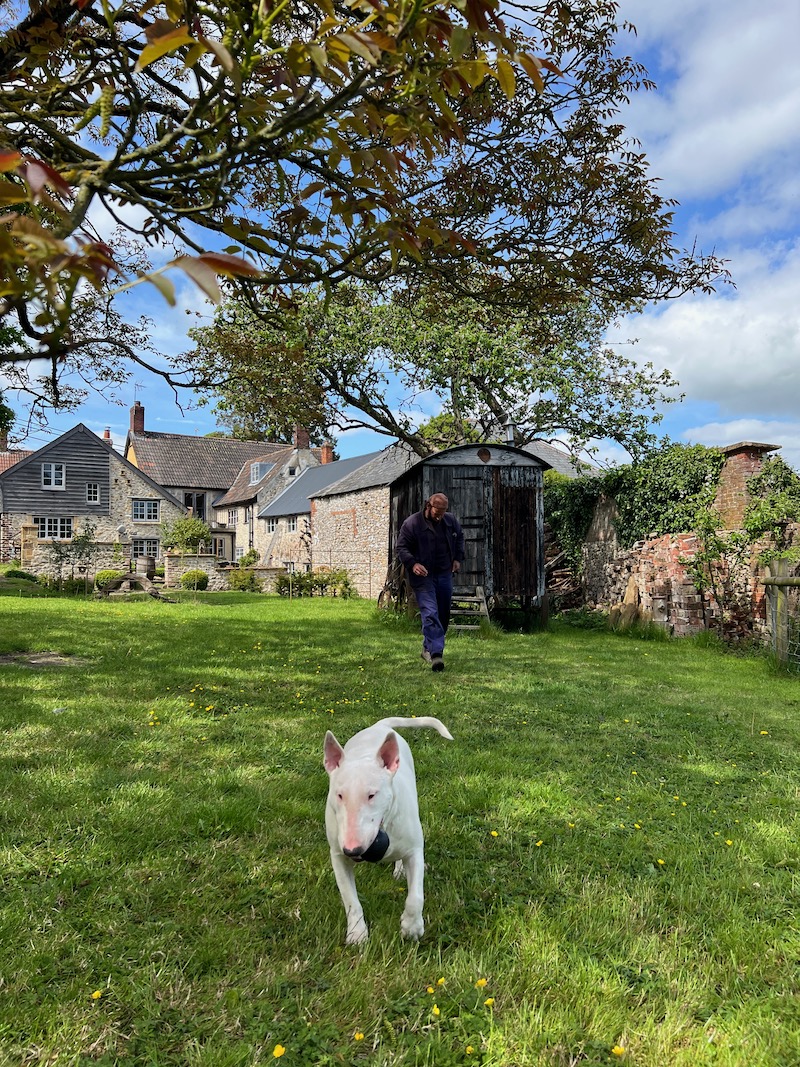
In the cottage, we’re trying to find the right colour limewash for the walls and we’re trying to get the bull terrier pink, the colour around her eye and muzzle
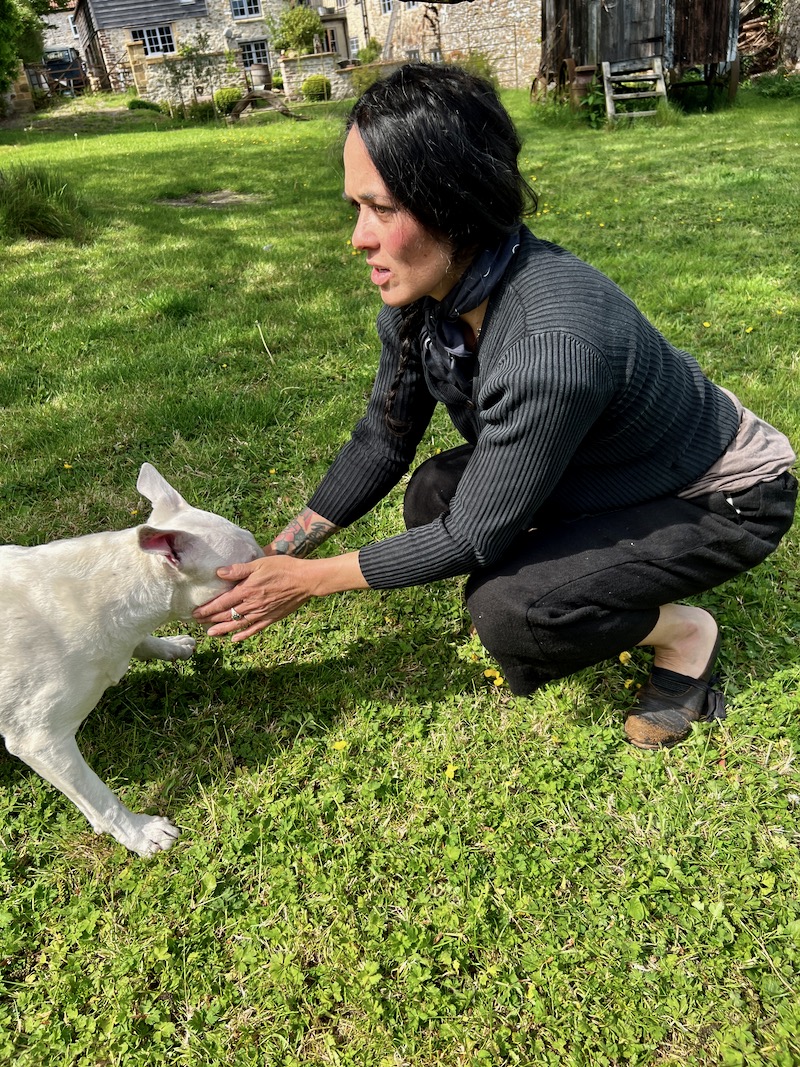
‘Walking with Queenie – its like walking a Landrover!’
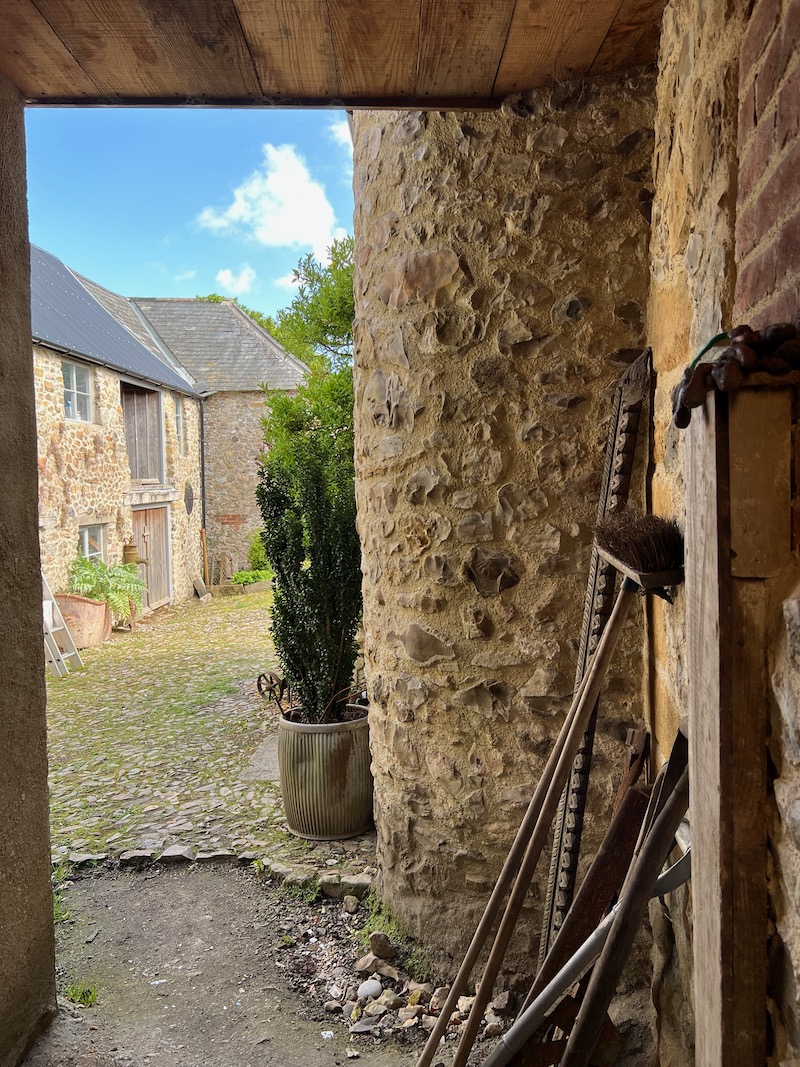

The new work now in progress, the tiny formerly derelict cottage in the yard behind the house. Everything here was hand built by Cameron, it smells of wood and lime mortar ,there are salvaged panels of old elm, and box beds. It was re-fenestrated with old windows saved from a bonfire at the farmhouse next door, and for the longer curtain poles there are WWII era stretcher poles. ‘I grew up in an authentic cottage, A simple workman/s cottage of flint and brick, so I had an appreciation of materials and honesty. Then I went to London and worked there and forgot about it. I was living in Whitechapel and thinking about block printing but I had a love-hate relationship with advertising – and towards the end I had to resign. When we came back to Dorset and rented that little cottage it all came back.’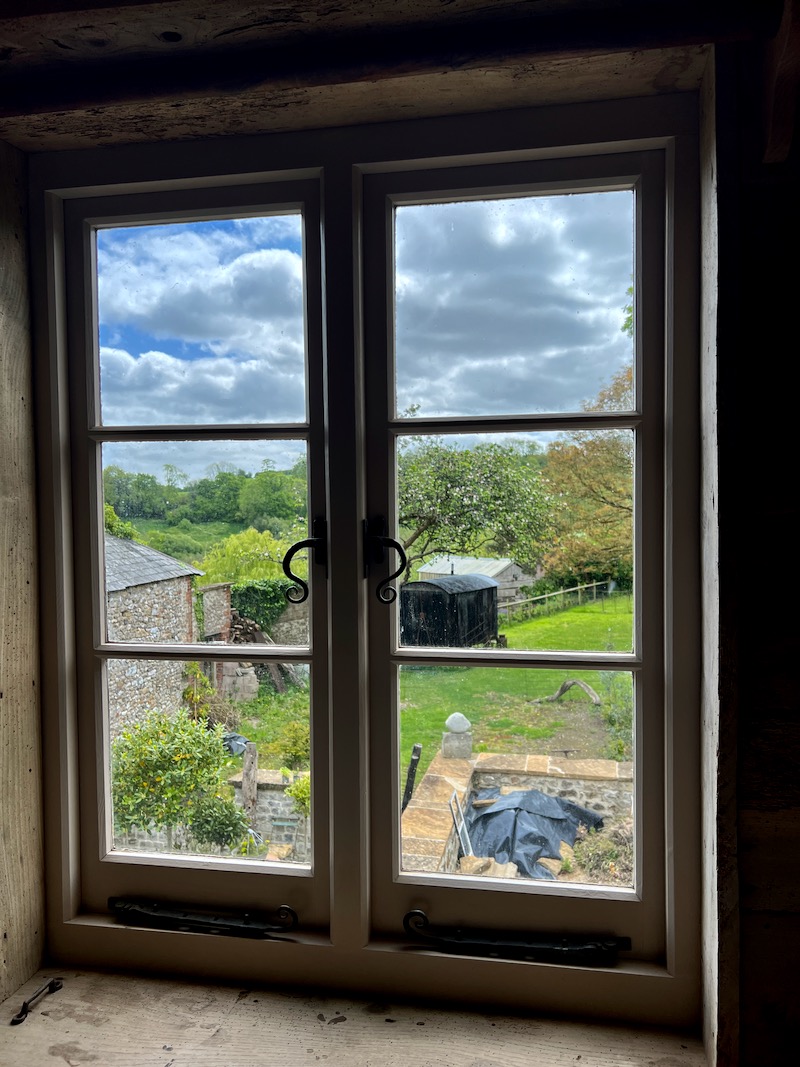
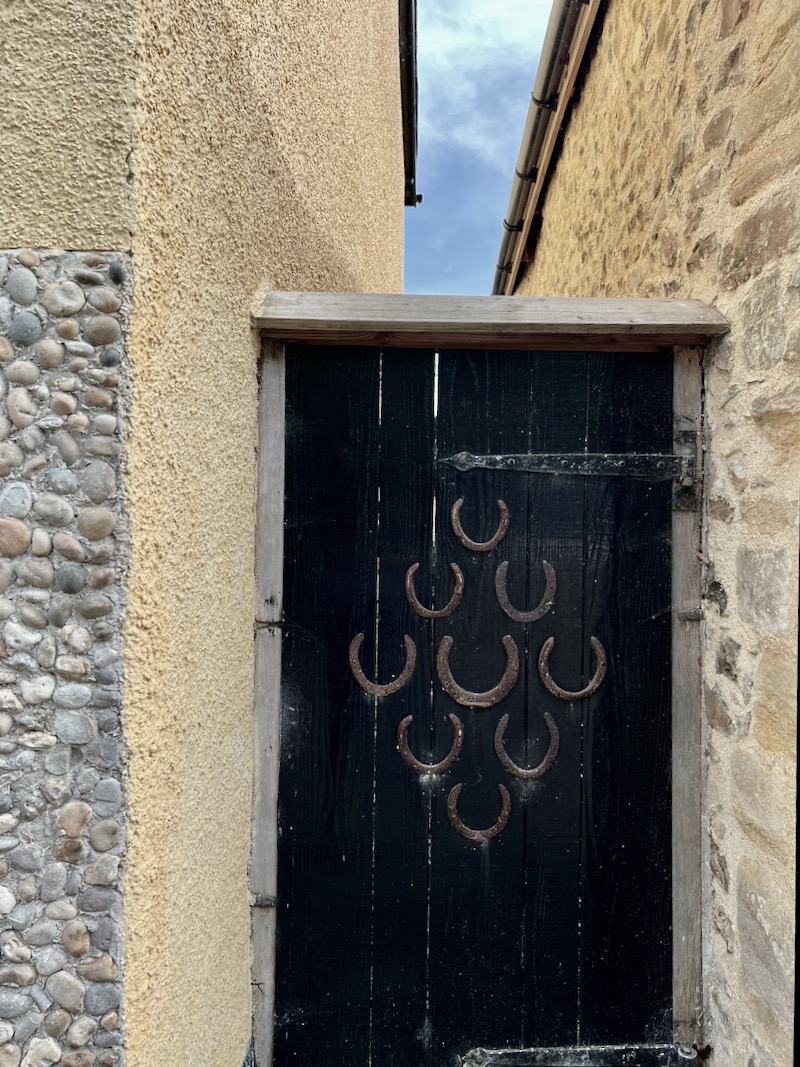
horseshoe diamond for luck
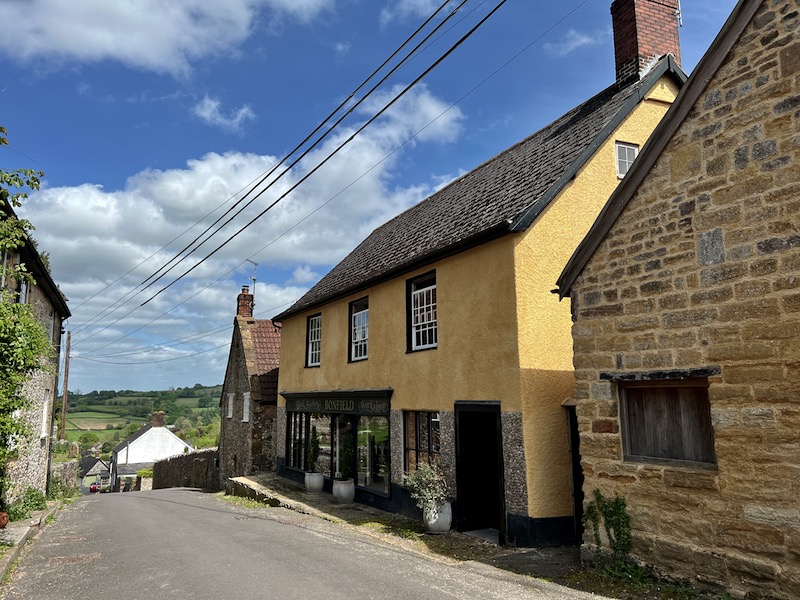
‘It’s ideas that excite us and fulfilling ideas. Our biggest challenge is – we’ve got all these ideas but its finding the time to realise them.’

‘Diversification is our strength and our weakness – but we enjoy it’
Very many thanks to Janet and Cameron Short. All photographs copyright bibleofbritishtaste and Bonfield Block-Printers. Excerpts may be used as long as clear links are supplied back to the original authors and content.



I had been waiting to see this! And now I have! How beautiful, the lives gifted people lead. Authentic and useful and beautiful. I enjoyed the notion of the charm of finding things in the soil. Interestingly, at least to me, today, picking up a comb from my sink counter, I imagined finding one, an old one, made of what, wood, bone? So much more interesting. Just a passing fancy. In my neck of the woods, one is apt to find plastic on the ground. This evening, in a restaurant parking lot, I spied something miniscule, bizarre, hovering close to an urn. A tiny plastic dog, something abandoned by a feckless child, sitting on its haunches, once with a head that swiveled on a ball socket, head gone, the ball socket a perfect sphere, all looking like a monster dreamt up by Max Ernst. No wonder the child dropped it.
Anyway, I had been perusing your site faithfully, looking for new adventure, and you have kindly obliged! Thank you, and thank you to Janet and Cameron Short, who have improved the world with their industry.
WHATTA WEBSITE!
Overwhelming! Thank you so much Janet, Cameron and Ruth for these wonderful photographs and words. They are so inspiring!
What a sense of….Life. Full of the stuff. Cam and Jan’s simple, creative heartbeat. Honest, authentic, getting on with it. 💚
Thank you for sharing the home you’ve created. It gives me joy to look at your art with the clear interiors. Fantasy for me; but I can receive so much by looking at pictures.
What a delicious article. I am savoring every word and basking in the delight of the honesty displayed here, both in materials and storytelling. Thank you for continuing this blog, it is a joy to read!
This was such a pleasure to read. I love that Cameron left advertising for this creative life.
soy una colombiana apasionada por las antiguedades y la literatura, jubilada ahora vivo en el campo. encontre vuestro sitio “Biblia del gusto britanico” por casualidad y desde entonces estoy maravillada, que hermosas imagenes, que bellas historias. mi agradecimiento por el placer de leeros.
I was intrigued by Cameron and Janet after seeing them on an old Escape to the Country. This lead me to Google them. The pictures of their home are so beautiful, soulful and gives me a sense of nostalgia. I love their story and vision. Good luck in everything you do.